Samaaro + Your CRM: Zero Integration Fee for Annual Sign-Ups Until 30 June, 2025
- 00Days
- 00Hrs
- 00Min
In the world of complex B2B sales, digital marketing alone can only take you so far. While automated funnels, webinars, and email sequences play a critical role, they often fall short when it comes to building real relationships and accelerating enterprise-level decision-making. That’s where Field Marketing in B2B steps in.
Field marketing bridges the gap between digital outreach and high-touch engagement, offering a direct, personalized way to connect with key accounts. It enables marketers to activate tailored, on-the-ground experiences that resonate with buyers, drive meaningful conversations, and push opportunities further down the B2B sales pipeline.
In-person and experiential events remain one of the most powerful tools for B2B brands. From trade shows to executive roundtables, these high-impact formats foster trust, encourage dialogue, and drive decisions faster. Whether you’re trying to generate high-quality leads, deepen customer relationships, or close enterprise deals, Field Marketing Lead Generation through events consistently proves its value.
Done right, B2B event strategy goes beyond brand exposure — it becomes a critical growth lever. Strategic event touchpoints can align marketing and sales, bring ICPs into your ecosystem, and even accelerate the sales cycle.
This guide is designed to help you harness the full potential of field marketing for B2B growth. We’ll break down:
Whether you’re planning your first activation or refining a mature field marketing program, this guide offers practical steps to elevate your events and grow your pipeline.
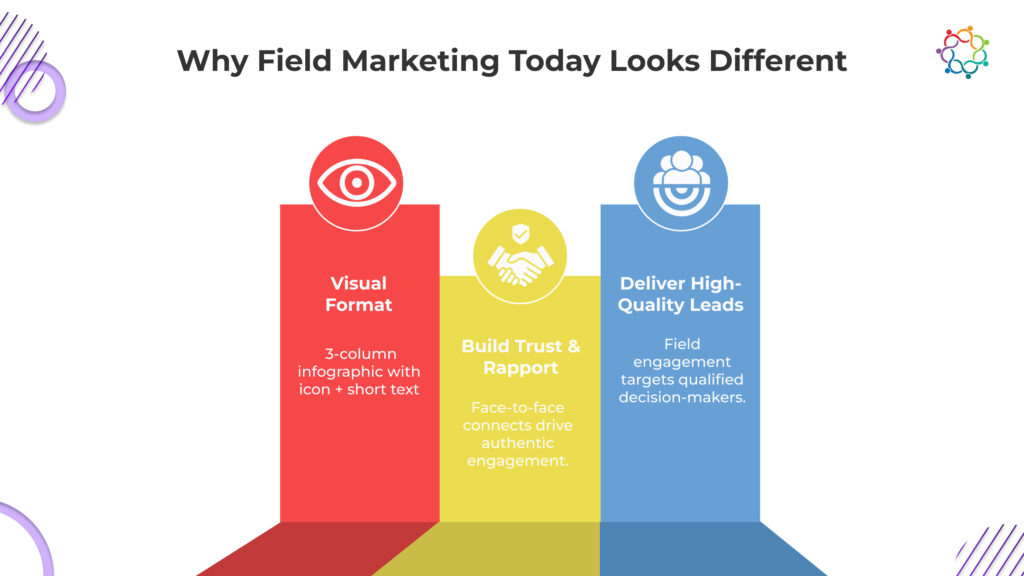
Before diving into tactics, it’s essential to build a strong foundation for your Field Marketing B2B strategy. This means setting clear goals, understanding who you’re targeting, and choosing the right event formats to meet those goals. Without this groundwork, even the best-executed events may miss the mark.
Success in B2B event planning starts with clarity. What do you want your field marketing efforts to achieve?
Whether you’re looking to generate Marketing Qualified Leads (MQLs) and Sales Qualified Leads (SQLs), accelerate deal velocity, boost brand visibility in a specific region, or improve customer retention, your objectives should be measurable and closely aligned with business outcomes.
Aligning on these goals early also ensures that your event sales pipeline metrics — from lead capture to revenue attribution — can be properly tracked and optimized.
You can’t craft an impactful B2B event strategy without knowing who you’re speaking to. Start by defining your ideal customer profiles (ICPs) and detailed buyer personas — what challenges they face, how they make purchasing decisions, and what kind of content or experiences resonate with them.
This insight will guide everything from the messaging you use in your pre-event campaigns to how you design the on-site experience. It also helps you choose the right type of event, timing, and location — all of which are key when planning for Field Marketing Lead Generation.

Not all events serve the same purpose — and not all will be right for your goals. A strong B2B field marketing portfolio blends different formats and scales to match various stages of the buyer journey.
The best B2B event strategies aren’t just about planning logistics — they’re about strategically moving prospects through the sales funnel. From the first touchpoint to the final handshake, every stage of the event lifecycle offers opportunities for Field Marketing Lead Generation and pipeline acceleration.
Field marketing success starts long before the event begins. Pre-event engagement sets the tone and ensures that the right attendees — especially decision-makers from your target accounts — show up ready to engage.
This proactive approach can dramatically improve turnout and prime your audience for interaction, especially at ABM events where relationship depth matters.
Once the event is underway, your goal shifts to making every moment count. A memorable, value-driven on-site experience drives both interest and intent.
These tactics help position your brand as a trusted partner, not just a vendor — a crucial distinction in B2B event planning best practices.
Every high-impact interaction should lead to a clear next step. That’s where tech-enabled lead capture and qualification systems come into play.
The faster your team can act, the more likely those event-generated leads will move through the pipeline — reinforcing the event’s role in accelerating the B2B sales cycle.
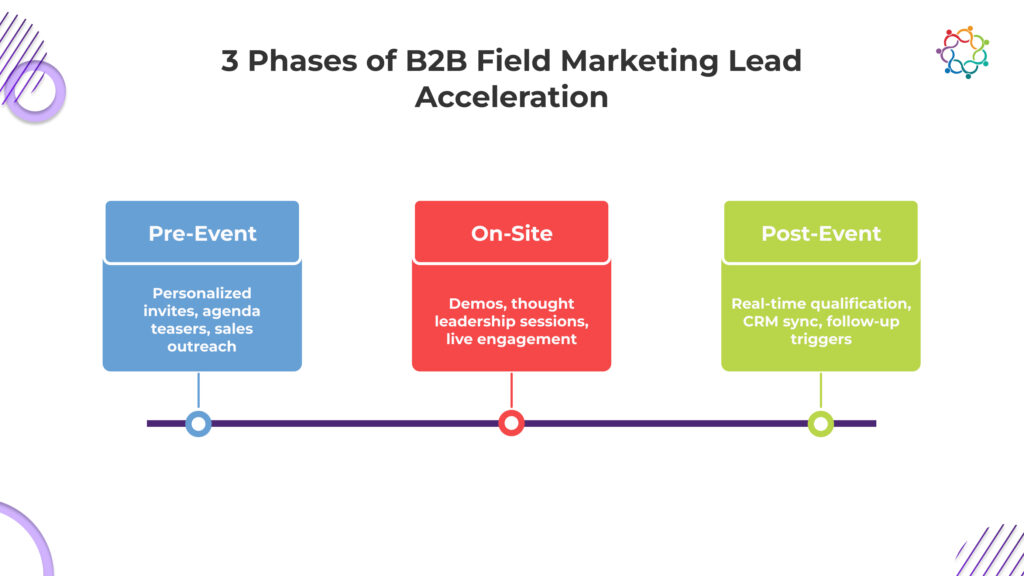
In B2B, meaningful connections don’t happen by accident — they’re designed. This is where experiential marketing and Account-Based Field Marketing (ABM Events) elevate your field strategy from functional to unforgettable. By focusing on emotional resonance and tailored interactions, you build stronger relationships with the accounts that matter most.
Today’s decision-makers expect more than product brochures and static displays. They want to experience your brand.
That’s where experiential field marketing for B2B events shines. These high-touch moments are crafted to spark curiosity, drive engagement, and leave a lasting impression.
Consider:
These tactics move you from vendor to value partner, building trust and brand loyalty — key factors in B2B event success.
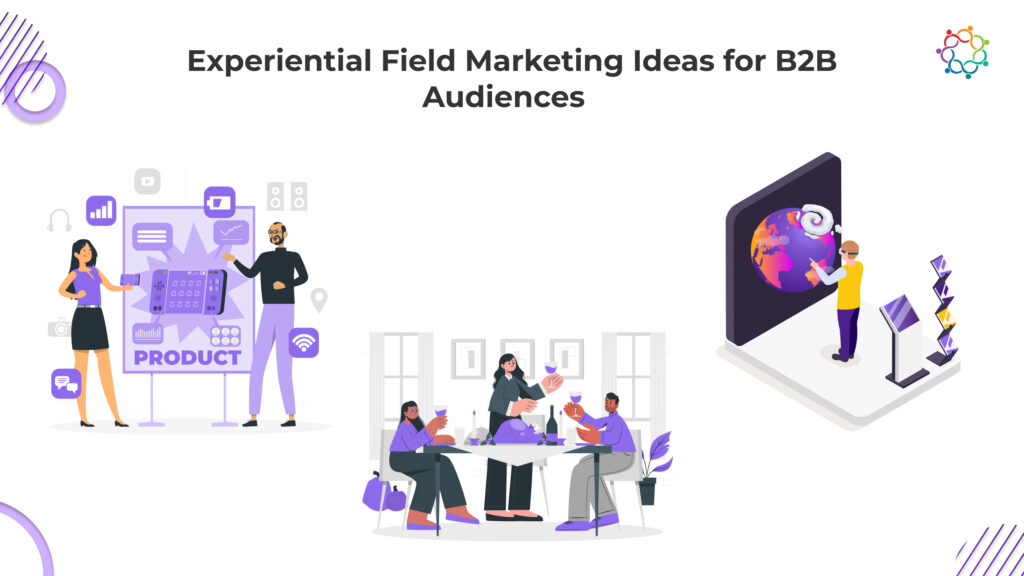
Experiential tactics gain even more traction when paired with Account-Based Marketing. With ABM, your events aren’t just broadly targeted — they’re laser-focused on high-value accounts.
Here’s how to align your Field Marketing B2B efforts with ABM strategy:
These ABM event tactics not only deepen relationships but also directly impact revenue. With curated experiences and focused targeting, you can accelerate deal progression, shorten sales cycles, and increase win rates — all while demonstrating the ROI of your field marketing lead generation efforts.
The event might be over, but its impact is just beginning. What you do in the hours and days after a B2B event can determine whether your investment translates into pipeline — or gets lost in the noise.
One of the best B2B event planning best practices is immediate follow-up. Time kills deals — especially when field marketing has done the hard work of attracting the right prospects.
Start by:
This targeted, fast-moving approach shows your brand listens, remembers, and adds value — a critical step in event follow-up strategies for sales.
Field marketing doesn’t end at handoff — it thrives on sales and marketing alignment.
Ensure your sales team is equipped with:
When marketing and sales operate as one, the path from lead to deal is faster — and far more predictable.
It’s not enough to say an event “went well.” You need to prove impact — in metrics that matter.
Track key Field Marketing Lead Generation indicators:
Wrap it all in a digestible Field Marketing ROI report for internal stakeholders. This is how you ensure continued investment in the right channels — and build a data-driven case for future field marketing expansion.

In today’s complex B2B landscape, field marketing is no longer a “nice to have” — it’s a growth engine.
Throughout this guide, we’ve explored how high-impact B2B event strategies — from trade shows and roundtables to experiential activations and ABM-driven events — can:
But the real power lies in what follows: seamless post-event nurturing, sales alignment, and measurable ROI.
At its core, successful Field Marketing B2B isn’t just about events — it’s about creating meaningful human connections that move the needle on your business objectives.
Ready to transform your B2B event strategy and accelerate your sales pipeline?
Explore how Samaaro can empower your field marketing efforts — from event planning and execution to real-time analytics and ROI tracking.
Imagine this: You’ve lined up a brilliant speaker, crafted a compelling topic, and set the perfect date and time. But on the day of the webinar… no one shows up. Maybe a few attendees trickle in. The chat is quiet. The Q&A feels forced. It’s not the content that failed – it was the promotion.
In 2025, promoting a webinar requires far more than a few social posts and a generic email blast. The digital space is noisy, attention spans are short, and audience expectations are higher than ever. You need a strategic, multi-channel webinar promotion plan that not only grabs attention – but holds it, nurtures interest, and converts it into actual webinar attendance and engagement.
This blog is your 10-step blueprint for promoting a webinar successfully – built from real-world strategies that go beyond theory. Whether you’re a marketer aiming to boost lead generation through webinars, or a founder looking to grow brand visibility, this guide will help you:
If you’re wondering how to promote a webinar in 2025 and make it worth the time and effort – you’re in the right place. Let’s dive in.
Before you even think about crafting a single email or social post, you need to get crystal clear on who you’re talking to. Successful webinar promotion starts with a deep understanding of your audience – not just their job titles or industries, but what keeps them up at night and what solutions they’re actively searching for.
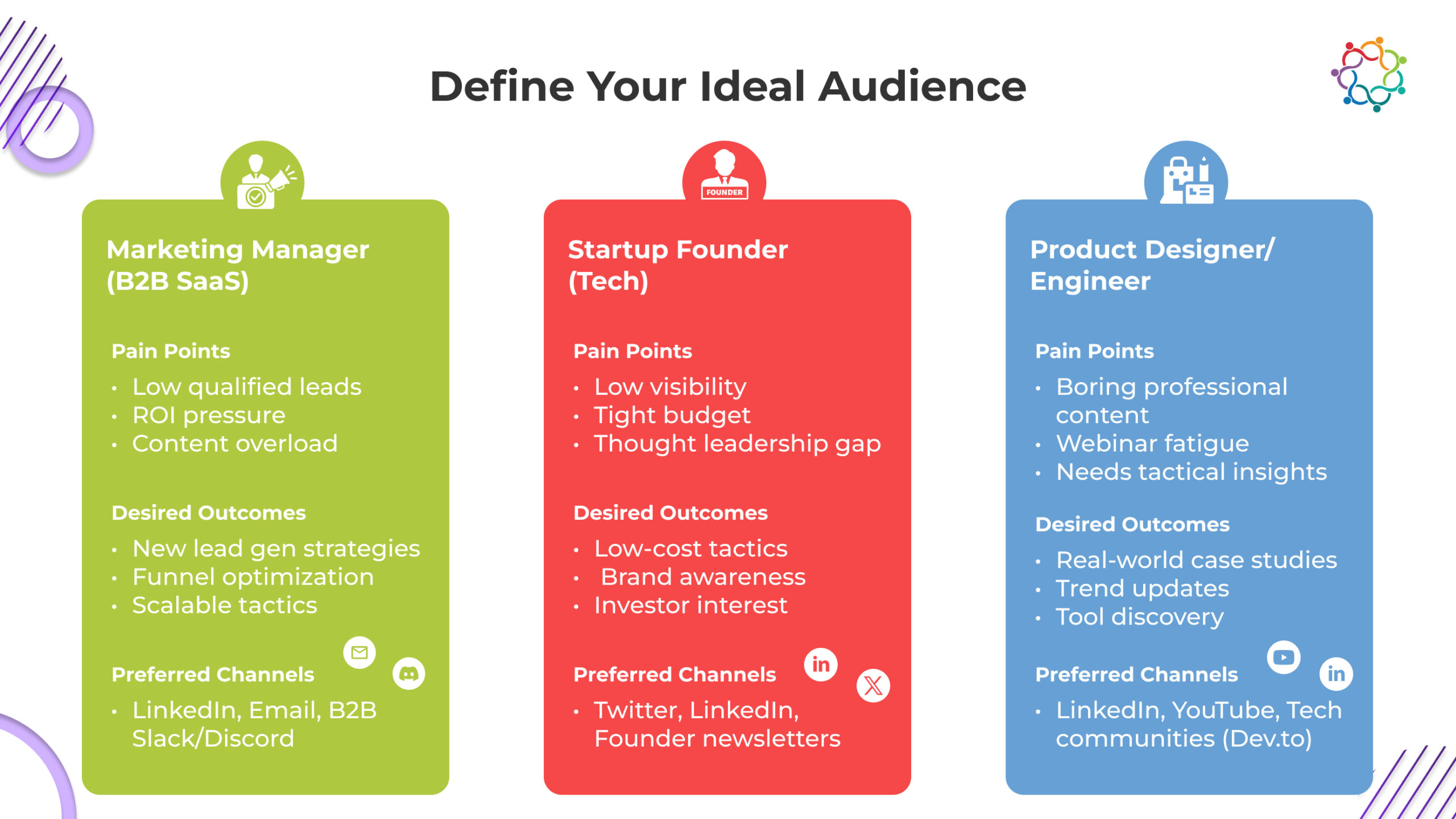
A common mistake is to cast too wide a net. When you try to appeal to everyone, you end up connecting with no one. Define your ideal attendees by demographics, professional roles, challenges, and goals. For example, are you targeting marketing managers struggling with lead generation? Or maybe small business owners looking to scale?
Dig deeper by building detailed audience personas. Think beyond the surface: What are their biggest pain points? What questions do they have about your webinar topic? What motivates them to sign up for events like yours? Use surveys, past webinar data, and customer interviews to paint a clear picture.
Once you know who you’re talking to, tailor every piece of your webinar promotion – from landing pages to emails – to speak directly to their needs. Use language that resonates with their challenges, highlight the solutions your webinar will deliver, and show them why this event is worth their time.
By starting with a well-defined audience, your webinar marketing efforts will feel intentional and focused – making it easier to increase webinar attendance and engagement naturally.
Your webinar landing page is the central hub of your promotion efforts – the place where curiosity turns into commitment. A well-designed, persuasive landing page can make the difference between a handful of sign-ups and a packed virtual room.

Think of your landing page as the handshake between you and your audience. It needs to be clear, trustworthy, and convincing. This is where your potential attendees decide if your webinar is worth their time.
To maximize webinar attendance, your landing page should include:
With over half of users browsing on mobile devices, your landing page must load quickly and display perfectly on any screen size. Mobile-friendly pages not only improve user experience but also support your SEO efforts, helping your webinar rank better in search results.
By optimizing your landing page with these elements, you create a seamless path for visitors to register – a crucial step in effective webinar promotion.
Despite the rise of social media and new marketing channels, email marketing for webinars remains one of the most effective ways to drive registrations and maintain interest. The inbox is a personal space – when used thoughtfully, it can turn curiosity into commitment.

Emails let you reach your audience directly with tailored messaging that’s hard to ignore. But to cut through the noise, your emails must offer clear value and a compelling reason to act.
A successful webinar email campaign uses multiple touchpoints:
Boost open and click-through rates by personalizing emails with recipient names, and segmenting your lists based on interests or behavior. For example, sending a slightly different message to leads who have attended past webinars versus brand new contacts can improve relevance and response.
Mastering webinar marketing through well-crafted email campaigns can significantly increase your webinar attendance and create an engaged audience eager to learn.
In today’s digital landscape, harnessing social media platforms for webinar promotion is essential. Social channels give you access to vast, engaged audiences – but success depends on strategy, not just posting the webinar link and hoping for the best.

Social media lets you connect with your audience where they already spend time. It also provides tools to target and engage potential attendees with precision, from organic posts to paid ads.
Eye-catching graphics and short video clips work wonders for grabbing attention in crowded social feeds. Share sneak peeks of your webinar content, speaker introductions, or quick tips that tie into your event theme to build excitement.
Going beyond basic posting by tailoring your social media strategy to each platform will amplify your reach and drive meaningful webinar attendance and engagement.
Promoting a webinar doesn’t have to be a solo effort. In fact, teaming up with the right partners can significantly extend your reach and lend credibility to your event. Whether it’s a co-host, an industry influencer, or a complementary brand, collaboration is a smart webinar promotion strategy – especially when you’re aiming to scale attendance.
Think about brands, creators, or organizations that serve the same audience but aren’t direct competitors. These are your ideal cross-promotion allies. A single mention in their newsletter or a shared post on their social media can expose your webinar to an entirely new (but relevant) audience.
Great partnerships are built on shared value. You can:
These collaborations also signal credibility – if your audience trusts your partner, they’re more likely to trust you.
Want to incentivize your partners further? Consider creating an affiliate program that rewards them for every registration they drive. It’s a win-win: you gain webinar attendance, they earn a reward, and your message spreads farther, faster.
When done right, strategic partnerships transform your webinar marketing from a campaign into a community-driven effort – boosting brand awareness and lead generation in the process.
Sometimes organic reach just isn’t enough – especially if you’re promoting a high-stakes webinar with lead generation goals or aiming to reach a fresh audience. That’s where targeted paid advertising comes into play. With the right strategy, paid ads can give your webinar promotion efforts a sharp, scalable boost.
Paid campaigns help you reach the exact people you want – fast. Whether it’s through Google Search, Facebook, or LinkedIn, targeted ads ensure that your webinar gets seen by individuals who are actively interested in your topic or fit your ideal customer profile.
This is especially useful in the final stretch before your webinar when organic reach might not deliver results quickly enough.
Different platforms serve different purposes:
Start with a modest daily budget and test different ad creatives, copy, and audiences. Double down on what performs.
Visitors who landed on your webinar landing page but didn’t register aren’t lost opportunities – they’re warm leads. Use retargeting ads to remind them of the event, highlight urgency, or showcase new value (like a confirmed speaker or bonus resource).
Paid ads, when run with a clear strategy and tight targeting, can dramatically improve webinar attendance and ROI, turning your marketing from passive to proactive.
One of the most overlooked aspects of promoting a webinar is what happens before the event. The period between someone registering and actually attending is critical – and often underutilized. By building anticipation through smart pre-webinar content, you not only reduce no-shows but also lay the groundwork for better webinar engagement.
Don’t go silent once someone registers. Keep the momentum going by teasing what’s to come – whether it’s a surprise guest, a valuable resource, or an exclusive takeaway.
Think of this phase as your “pre-launch runway.” The more excitement you generate, the more likely people are to show up and stay engaged.
Interactive touchpoints are a great way to warm up your audience:
This doesn’t just boost visibility. It makes attendees feel involved before the webinar even begins.
Repurpose parts of your webinar planning into micro-content:
This kind of snackable content not only reinforces your value proposition – it also works across email, social, and even internal channels.
How to promote a webinar in 2025? Tap into what your audience already cares about now. If there’s a trending issue, regulation change, or viral moment relevant to your topic – reference it. Timeliness creates urgency, and urgency drives action.
When you layer in compelling pre-webinar activities, you don’t just fill your virtual seats, you fill them with interested, engaged people who are primed to listen and convert.

You can craft the best webinar in the world – but if no one can find it, it won’t move the needle. That’s why search engine optimization (SEO) needs to be part of your webinar marketing plan. Think beyond just your blog – your actual webinar registration page should also be optimized for discoverability.
Start by treating your webinar landing page like a valuable piece of content. Is it optimized to show up in search results when someone types in terms like “how to in 2025” or “free webinar on ”?
Google indexes event pages, and people do search for webinars. Meet them there.
Use relevant keywords naturally throughout your page – just like you would in a blog:
Incorporate these in:
But remember: no keyword stuffing. Write for humans, then layer in the language search engines recognize.
Add event schema markup to your registration page. This helps Google understand your content and may even display your webinar as a rich result (date, time, and title) directly in search – boosting click-through rates.
Use your blog (like this one) as a central piece in your content hub – linking out to:
Interlinking improves SEO while offering readers a seamless journey through your content universe.
When you prioritize SEO as part of your webinar promotion, you’re not just chasing visibility – you’re laying the groundwork for long-term discoverability and organic traffic, even after your event has passed.
Your webinar shouldn’t be a one-and-done event. If you’ve taken the time to plan, promote, and execute a solid session, you’ve already created valuable content – don’t let it sit idle. Repurposing allows you to stretch your efforts, amplify reach, and continue generating value from your webinar long after it ends.
Think of your webinar as a content goldmine. You now have:
Each of these can become standalone content pieces that reinforce your brand and continue attracting leads.
Here’s how to break your webinar into digestible assets:
By slicing the webinar into smaller parts, you can drip content over time – keeping the conversation alive while boosting webinar engagement on other platforms.
Turn key sections of your webinar into educational blog posts, particularly ones that address trending questions or pain points. This not only improves SEO but also positions your brand as an ongoing resource.
Infographics are another great way to present insights, especially data or frameworks shared during the session. They’re highly shareable and can drive additional webinar marketing momentum.
Tip: Link these repurposed assets back to the full webinar recording or a gated replay page to continue generating lead generation opportunities.
When you consistently resurface high-value takeaways from your webinars across email, social media, and your website, you’re reinforcing your brand’s thought leadership. This creates multiple touchpoints that drive trust – and eventually, conversions.
Boosting brand awareness with webinars isn’t just about the event day – it’s about how long your message can live and thrive after the fact. Repurposing is what gives your webinar legs.
The webinar might be over – but your job definitely isn’t. In fact, the real ROI often comes after the event. What you do in the days that follow will determine how well you nurture leads, maintain engagement, and set the stage for future conversions.
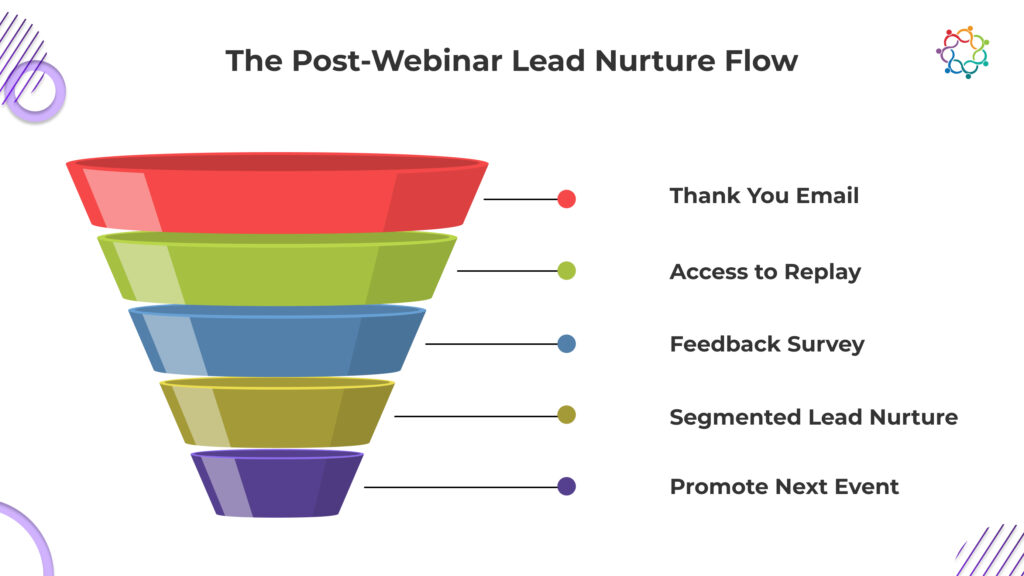
Webinar attendees have just spent 30 to 60 minutes engaging with your content. They’re warm, informed, and potentially interested – but if you don’t follow up promptly and purposefully, that attention fades quickly. That’s where effective follow-up activities after a webinar come into play.
A thoughtful follow-up sequence helps reinforce the value of the session and extends the relationship:
Timing matters: send your thank-you within 24 hours, the recording within 48, and the survey within 2–3 days max.
Not everyone who registers is sales-ready – but they’ve shown interest. Segment your list based on:
Now tailor your nurture campaigns:
This is where webinar lead generation turns into actual pipeline – if handled well.
Future Engagement
Your webinar is also a gateway to a broader relationship:
Keep the conversation alive – and build trust with every interaction.
A well-run follow-up strategy is the difference between a one-time viewer and a long-term customer. If you want to truly increase webinar attendance and participation, start thinking of the post-webinar phase as your most critical engagement window.
Promoting a webinar in 2025 isn’t just about sending a few emails or posting on social media – it’s about crafting a well-rounded, strategic journey that begins long before your webinar goes live and continues well after it ends.
This 10-step blueprint is designed to take you beyond the basics of webinar promotion, offering a clear path to:
From defining your audience and building a high-converting landing page, to leveraging email marketing, social media, SEO, partnerships, and repurposing content – every step is a building block toward webinar success.
But here’s the thing: even the most brilliant strategies mean nothing without consistent execution. The webinars that perform best are backed by teams (or individuals) who treat every promotion cycle as a chance to learn, improve, and connect more deeply with their audience.
Whether you’re a marketer, founder, or team of one – you now have a tactical guide to take your webinar from “just another event” to a lead-generating, engagement-driving powerhouse.
If you’re preparing for your next webinar, bookmark this blueprint. Better yet, start applying each step and track what works. You’ll be surprised how small changes in planning and promotion can lead to big leaps in attendance and impact.
And if you’re looking for a platform that brings all these strategies together – from landing page creation to email campaigns and post-webinar analytics – consider exploring Samaaro designed for modern teams like yours.
Imagine spending months planning the perfect event – incredible speakers, engaging content, a smooth schedule – only to see attendance fall short of expectations. It’s a scenario no event organizer wants to face, and more often than not, the missing piece is strategic event communication.
Event email marketing is the linchpin that connects your event’s promise with your audience’s participation. It’s far more than just sending a few reminder emails; it’s a targeted, systematic approach that drives registrations, builds anticipation, and keeps attendees engaged before, during, and after your event.
This step-by-step guide will serve as your blueprint for mastering event email marketing. From understanding what it truly means and why it matters, to crafting compelling campaigns and optimizing them with automation and personalization – you’ll get practical insights designed to boost your event’s success.
By following these proven strategies, you’ll learn how to drive registrations, increase attendee engagement through well-crafted emails, and ultimately ensure your event achieves its goals. Whether you’re launching your first event or looking to sharpen your marketing edge, this guide will help you communicate with clarity and confidence every step of the way.
Event email marketing goes beyond simply blasting out emails about your event. It’s a focused, strategic approach that uses email as a primary channel to connect with your audience throughout the event lifecycle. From the initial invitation to the final thank-you note, event email marketing helps build relationships, nurture interest, and drive meaningful actions.
Unlike general email marketing, event email campaigns are highly time-sensitive and goal-oriented. They include a mix of promotional, informational, and engagement-driven messages designed specifically to move attendees through your registration and participation funnel.
Key components of effective event email marketing include:
When it comes to promoting and running successful events, email marketing stands out as a cost-effective, measurable, and direct way to reach your audience. Here’s why it should be at the heart of your event strategy:
In the following steps, we’ll break down how to leverage this powerful tool to maximize your event’s impact.
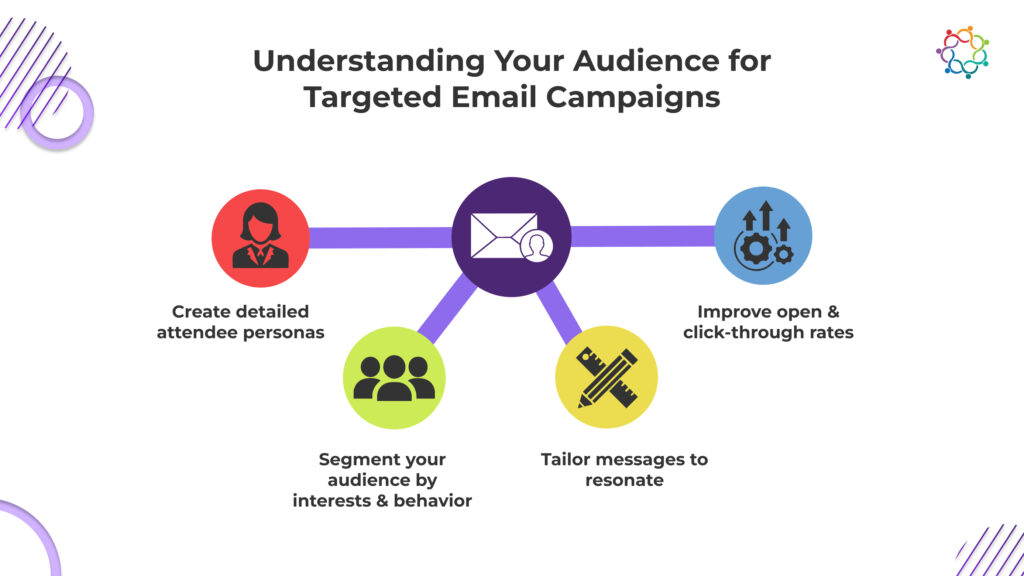
Before you start crafting emails, get crystal clear on your event’s objectives. Are you aiming to boost registrations, maximize actual attendance, increase engagement during the event, or drive sales afterward? Your goals will shape every message you send.
Having measurable goals helps you tailor your campaigns to move attendees toward those specific outcomes, whether it’s clicking a registration link, joining a session, or sharing feedback post-event.
Successful email marketing is all about relevance. To get there, start by creating detailed attendee personas. These aren’t just demographics – think about their interests, pain points, motivations for attending, and preferred communication style.
Once you have personas, segment your email lists accordingly. Segmenting means sending the right message to the right group, increasing the chances your emails will resonate and inspire action.
For example, new prospects may need more educational content about the event’s benefits, while returning attendees might appreciate insider previews or exclusive perks.
With clear goals and audience segments, craft messaging that speaks directly to each group’s needs and expectations. Use language and tone that match their preferences, and highlight the aspects of your event that matter most to them.
Remember, generic emails don’t perform. Personalization and segmentation are your best friends here.

Think of your event email marketing as a journey – from the first spark of interest to long after the event wraps up. Planning this journey means outlining every touchpoint where you’ll connect with your audience via email.
Start with pre-event communications to generate buzz and drive registrations. Then plan emails to keep attendees engaged leading up to the event. Finally, map out your post-event follow-ups to keep the momentum going.
Having a clear roadmap ensures your emails arrive at the right time with the right message.
Not all event emails are created equal. Some are designed to invite, others to remind, and some to engage or inform. Common types include:
Knowing what email types you need lets you create targeted content that fits each purpose.
Timing is everything in email marketing. Map your timeline based on key event milestones – registration open date, early-bird deadlines, speaker announcements, and of course, the event date itself.
For example, send your first invitation as soon as registration opens, reminders closer to the event, and follow-ups right after it ends.
A well-planned timeline keeps your audience informed and engaged, reducing last-minute rushes and forgotten events.
Your invitation email is your first impression – make it count. Craft subject lines that grab attention and clearly communicate the value of your event. Highlight key speakers, unique benefits, or exciting sessions that attendees won’t want to miss. Always end with a clear, compelling call to action (CTA) that makes registering easy.
Once someone registers, your confirmation email sets the tone. Include essential details: event date and time, location or access link, agenda highlights, and what the attendee should do next. Use this email to build excitement and assure participants they made the right choice.
Send reminders at key intervals – one week, one day, and even an hour before the event. These emails reduce no-shows by keeping your event top of mind. Share last-minute tips, what to prepare or bring, and add a sense of urgency to encourage attendance.
Keep the anticipation alive by sharing teaser content between your reminders. This could be speaker sneak peeks, exclusive insights, or mini-guides related to your event topic. These value-add emails deepen interest and show attendees what to expect.
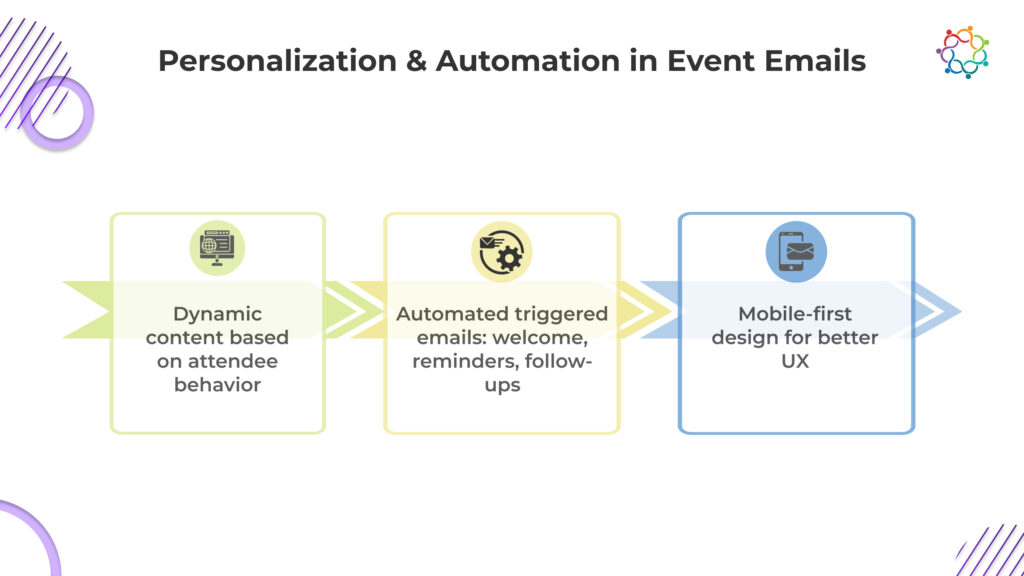
Personalization goes beyond just using the recipient’s name. Leverage data like past event attendance, interests, and behavior to tailor your email content dynamically. Customized recommendations, personalized agendas, or location-specific info can significantly boost engagement and show your audience you understand their needs.
Automation saves time and ensures timely communication. Set up triggered email sequences for key actions like welcome emails after registration, reminders leading up to the event, and follow-ups post-event. This not only streamlines your communication but also keeps your event top of mind without extra manual effort.
Most emails are opened on mobile devices, so mobile-friendly design is a must. Use clear, concise copy, large buttons, and responsive layouts that adapt to different screen sizes. Test your emails across devices to make sure they look great and function flawlessly, ensuring your attendees have a smooth experience from inbox to event.
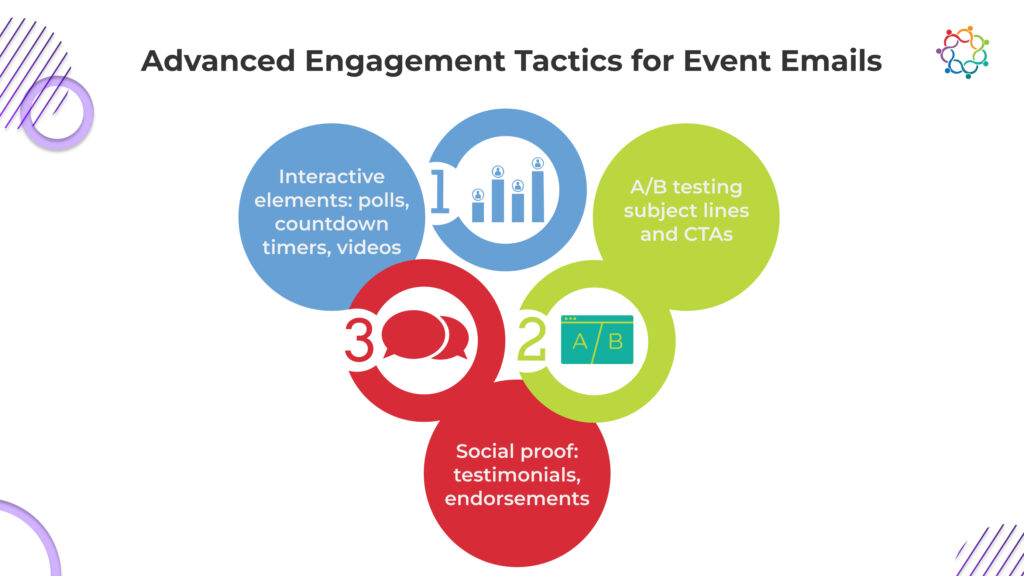
Interactive content like polls, countdown timers, embedded videos, and GIFs can make your emails more engaging and memorable. For example, a countdown timer builds excitement by showing how much time is left to register, while polls can gather quick feedback or preferences from your attendees. These elements invite recipients to interact directly within the email, boosting click-through rates and attendee interest.
Testing different subject lines, calls to action (CTAs), visuals, and send times helps you understand what resonates best with your audience. Run A/B tests regularly to refine your messaging and design, improving open rates and conversions over time. Even small tweaks can have a significant impact on your campaign’s success.
Including quotes from past attendees, speaker endorsements, or social media highlights adds credibility and builds trust. Showcasing positive experiences from previous events can reduce hesitation and encourage registrations. Social proof also helps humanize your event, making it feel more relatable and valuable.
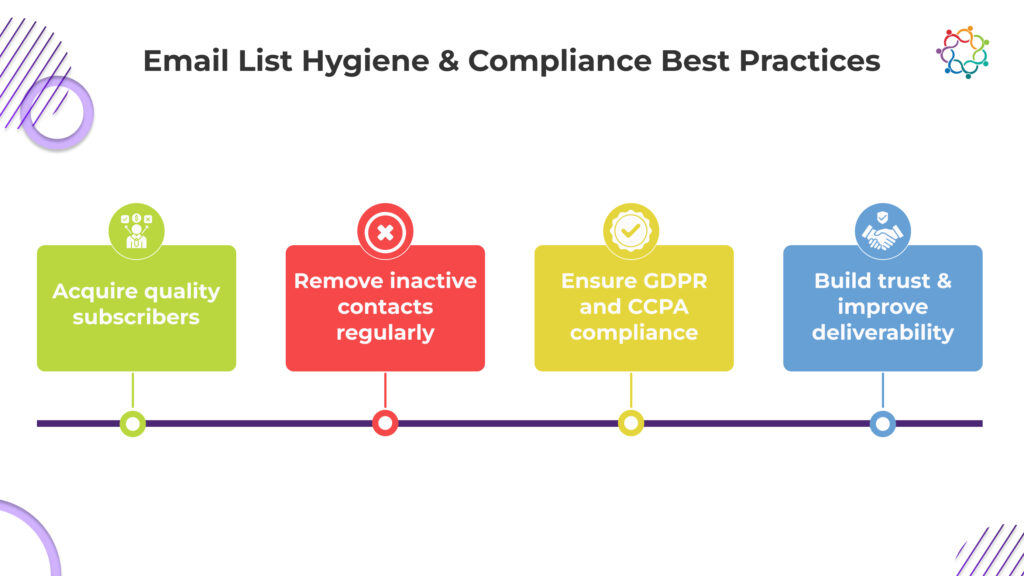
Keeping your email list clean, engaged, and compliant is crucial for effective event email marketing. A healthy list ensures your emails reach the right people and avoid spam filters, improving your overall campaign performance.
By mastering list hygiene and compliance, you enhance deliverability, build credibility, and set the foundation for successful email marketing for events campaigns.
To continuously improve your event email marketing efforts, tracking and analyzing key performance indicators (KPIs) is essential. Understanding these metrics helps you refine your strategy and maximize attendee engagement.
Tracking these metrics ensures your email marketing for events stays effective and evolves with your audience’s needs.
Your event email marketing doesn’t end when the event wraps up. Post-event communication plays a crucial role in nurturing relationships, gathering insights, and setting the stage for future events.
By implementing thoughtful post-event email campaigns, you extend the life of your event and strengthen connections with your audience.
Mastering event email marketing is essential for any event organizer aiming to boost registrations, increase attendee engagement, and maximize event success. By following the step-by-step blueprint shared here, from understanding your audience and crafting targeted campaigns to leveraging automation, personalization, and post-event follow-up, you can create impactful email communication that drives real results.
Remember, effective email marketing is not just about sending messages; it’s about delivering the right message, to the right people, at the right time. Use the strategies outlined in this guide to build meaningful connections with your attendees, nurture leads, and keep your events top of mind long after they end.
Ready to elevate your event communication? Start building your event email marketing blueprint today and watch your events thrive.
Explore our comprehensive guide for deeper strategies: Best Email Marketing Strategies for Event Promotion in 2025: Reaching Diverse Audiences.
In 2025, micro events are redefining how companies engage their teams, offering purposeful, compact formats that deliver impact without the overhead of large-scale gatherings. Whether it’s a 60-minute brainstorming sprint or a themed culture-building activity, corporate micro events are becoming a go-to strategy for driving connection, collaboration, and creativity in the workplace. As workplace dynamics evolve, there’s a growing demand for small-scale corporate events that are agile, budget-friendly, and aligned with employee interests. These micro event ideas don’t just boost morale, they support broader goals like knowledge sharing, team bonding, and internal communication.
In this blog, we’ve curated 20 creative micro event formats tailored for internal company events in 2025. From energizing team building activities to meaningful CSR moments, each idea is designed to spark inspiration and elevate your company culture.
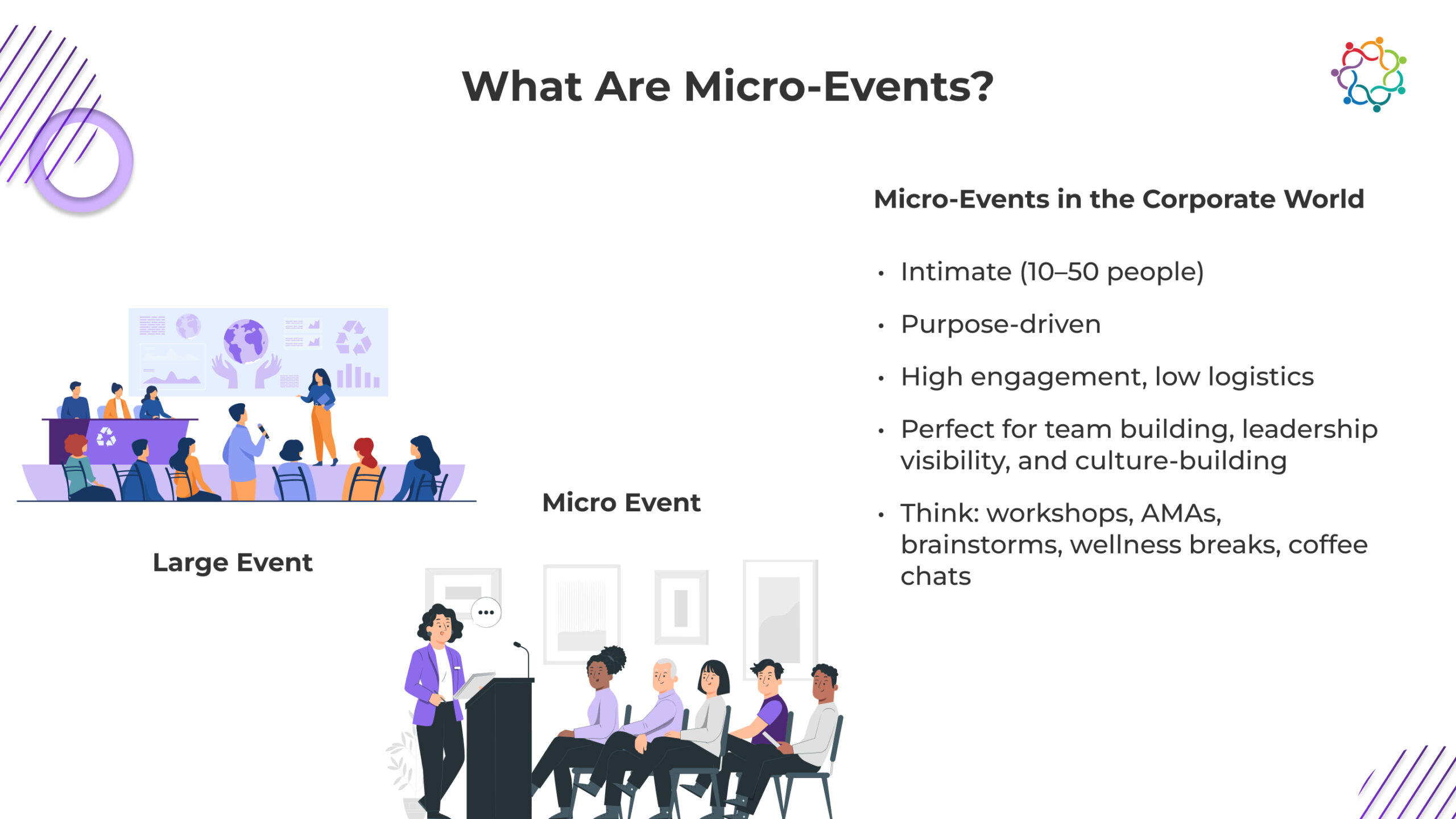
When it comes to micro events that drive collaboration in the workplace, nothing beats activities designed specifically for team building. These small-scale corporate events are perfect for strengthening interpersonal relationships, breaking silos, and encouraging creativity, without pulling teams away for an entire day. Below are five micro event ideas that are quick to execute and high on engagement:
Host a 3- to 4-hour hackathon where teams solve a real business challenge or innovate around a fun hypothetical. Whether it’s brainstorming a new feature or reimagining an internal process, these team building events bring out problem-solving, teamwork, and presentation skills. It’s one of the most effective micro events for both engagement and insight generation.
Bring in a dose of friendly competition with quick-fire games like chair races, paper toss, and office trivia. This is a classic yet highly customizable idea for corporate micro events, especially when you’re aiming to boost energy mid-week or after a tough quarter. You can even theme it to reflect company values or upcoming milestones.
Give small groups a fictional problem (e.g., “How would our team work on Mars?”) and 90 minutes to pitch a wild solution. These are ideal micro events for sparking creativity and out-of-the-box thinking, plus, they offer a fun break from routine while encouraging collaboration.
Set up a lounge space with games like Codenames, Dixit, or Pictionary. It may sound simple, but it’s a tried-and-tested format for encouraging informal communication and team bonding. For hybrid teams, virtual board game platforms can be a great alternative.
Pair employees from different departments, give them a recipe (or mystery ingredient box), and let them cook up something fun. This is a playful twist on traditional team bonding ideas for micro events, and it’s great for breaking down hierarchies while creating shared memories. Bonus: the team gets to enjoy a meal together afterward.
Micro events aren’t just for fun, they’re a powerful tool for learning and growth when designed with purpose. These corporate micro events can be hosted monthly or even quarterly to support continuous development without overwhelming teams. Each activity below is crafted to nurture new skills, encourage knowledge sharing, and support personal and professional growth in a time-efficient way.
Create a monthly micro event where team members teach each other something new,professional or personal. A designer might teach basic visual storytelling, while an engineer walks through no-code automation tips. It’s one of the most low-cost, high-impact internal company events that builds community while fostering a culture of learning.
Invite team members to present short, 5–7 minute talks on topics they’re passionate about, from emerging industry trends to niche tools they’ve mastered. These micro event formats are a great way to spotlight internal talent and encourage public speaking in a safe space.
Host quick, structured sessions where senior team members rotate across small groups for 15-minute Q&As. This keeps mentoring approachable and scalable, especially in growing companies. It’s an innovative twist on traditional employee engagement activities that helps build trust and transparency.
Turn lunch breaks into optional skill-up moments with short talks, expert panels, or book summaries. These small-scale corporate events are great for employee enrichment while keeping things informal and low-pressure. You can even crowdsource topics based on employee interests.
Instead of traditional top-down feedback, these sessions invite junior team members to share insights with leadership in a moderated, constructive format. It’s a bold and modern approach to micro event planning that encourages open dialogue and fresh perspectives.
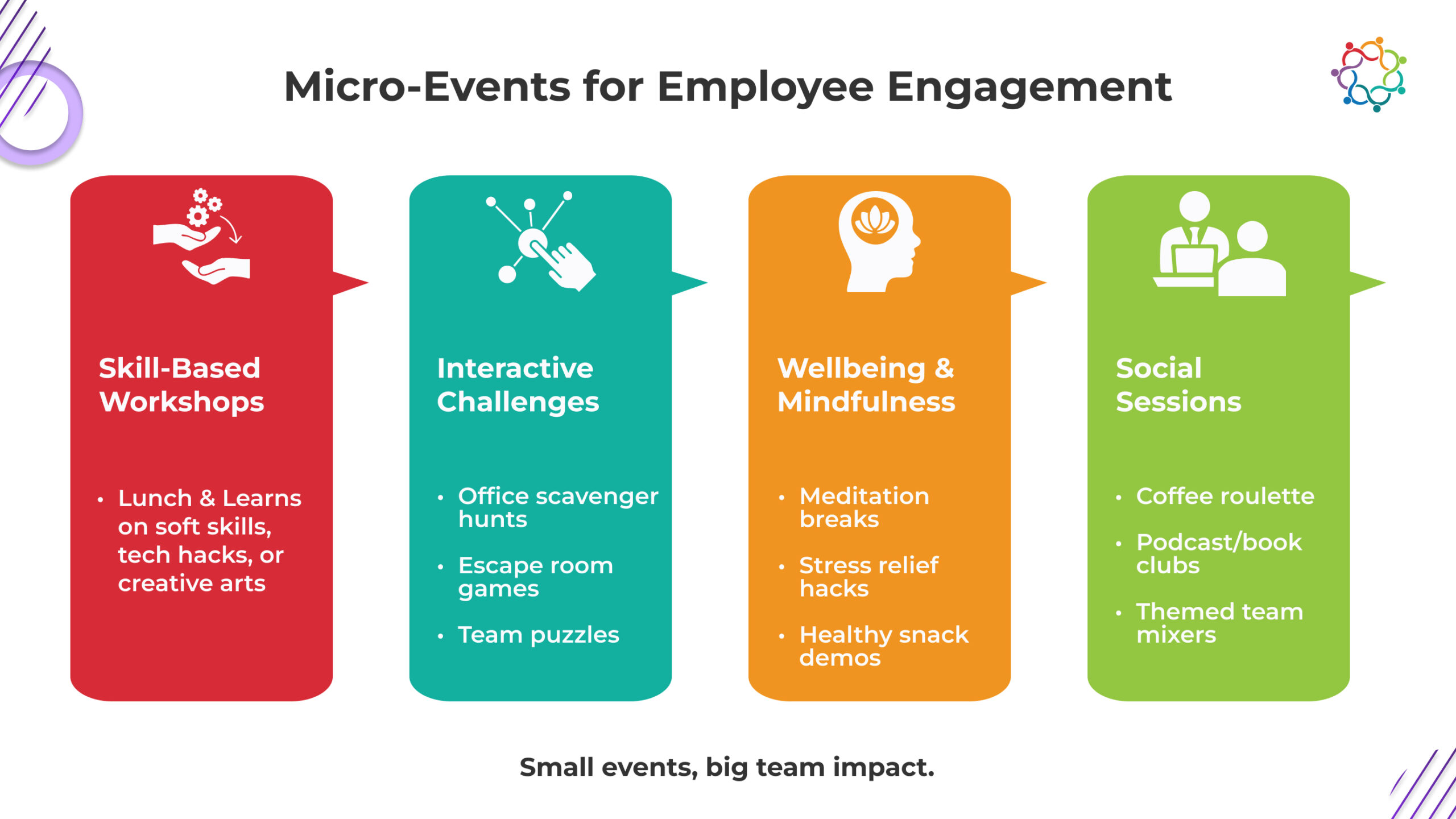
Culture isn’t built through posters or policies, it’s shaped by everyday experiences. These creative corporate events focus on well-being, empathy, and shared values, all wrapped into short, meaningful formats. In a hybrid, fast-paced world, these employee engagement activities are essential for maintaining morale and strengthening team identity.
Host short, 10–15 minute guided meditations during the workday, led by professionals or even trained employees. These quick sessions reduce stress, increase focus, and make wellness feel like a shared value. Perfect for a recurring, low-effort micro event format that centers mental health.
Gather teams for a monthly storytelling circle around a theme, “first week at work,” “most memorable team moment,” or “a personal challenge I overcame.” These internal company events are powerful for deepening human connections, especially in diverse or distributed teams.
Create a month-long bingo card with self-care challenges: 10-minute walks, gratitude journaling, hydration goals, or digital detox hours. Announce winners in a short, celebratory wrap-up event. It’s an engaging way to tie personal wellness into micro event planning.
Recognize employees who embody company values with short spotlight sessions. Peers or managers can nominate someone and briefly share what they did and why it mattered. These small-scale corporate events reinforce culture through real, relatable stories.
Dedicate an hour for a CSR-focused micro event, writing notes for local shelters, assembling care kits, or connecting with nonprofits. It’s one of the most impactful corporate micro events for showing that your company culture extends beyond the workplace.
In today’s fast-paced business world, staying ahead requires constant creativity and out-of-the-box thinking. These micro events are all about inspiring new ideas, fostering innovation, and giving your team the space to explore without the constraints of traditional brainstorming sessions. Whether through structured play or spontaneous collaboration, these corporate micro events energize teams and spark creative breakthroughs.
Set up a digital or physical “innovation wall” where employees can post any new idea, big or small,at any time. Each month, gather the team to discuss the best or most interesting ideas. This micro event format ensures that creativity is always encouraged and never stifled.
Think of it like speed dating, but for brainstorming. Set up short 5-minute idea exchange rounds where employees pitch their current challenges or new projects to a new colleague. This promotes cross-team collaboration and inspires fresh solutions. It’s an ideal employee engagement activity for encouraging diverse perspectives in a short amount of time.
Host a mini design thinking workshop, where teams tackle a problem or customer need in a creative, iterative process. By using tools like empathy mapping and prototyping, these micro events help employees develop practical innovation skills that benefit the company.
Host a casual event where employees showcase their personal creative projects,whether work-related or hobbies they’re passionate about. From artwork to side business ideas, this gives employees the freedom to express themselves. It’s a great way to connect personal creativity with company culture.
Similar to an innovation sprint but with a focus on nurturing ideas over time, these micro events allow employees to pitch ideas that are incubated with feedback and resources over a few weeks. At the end of the cycle, participants present their refined ideas to leadership for potential implementation.
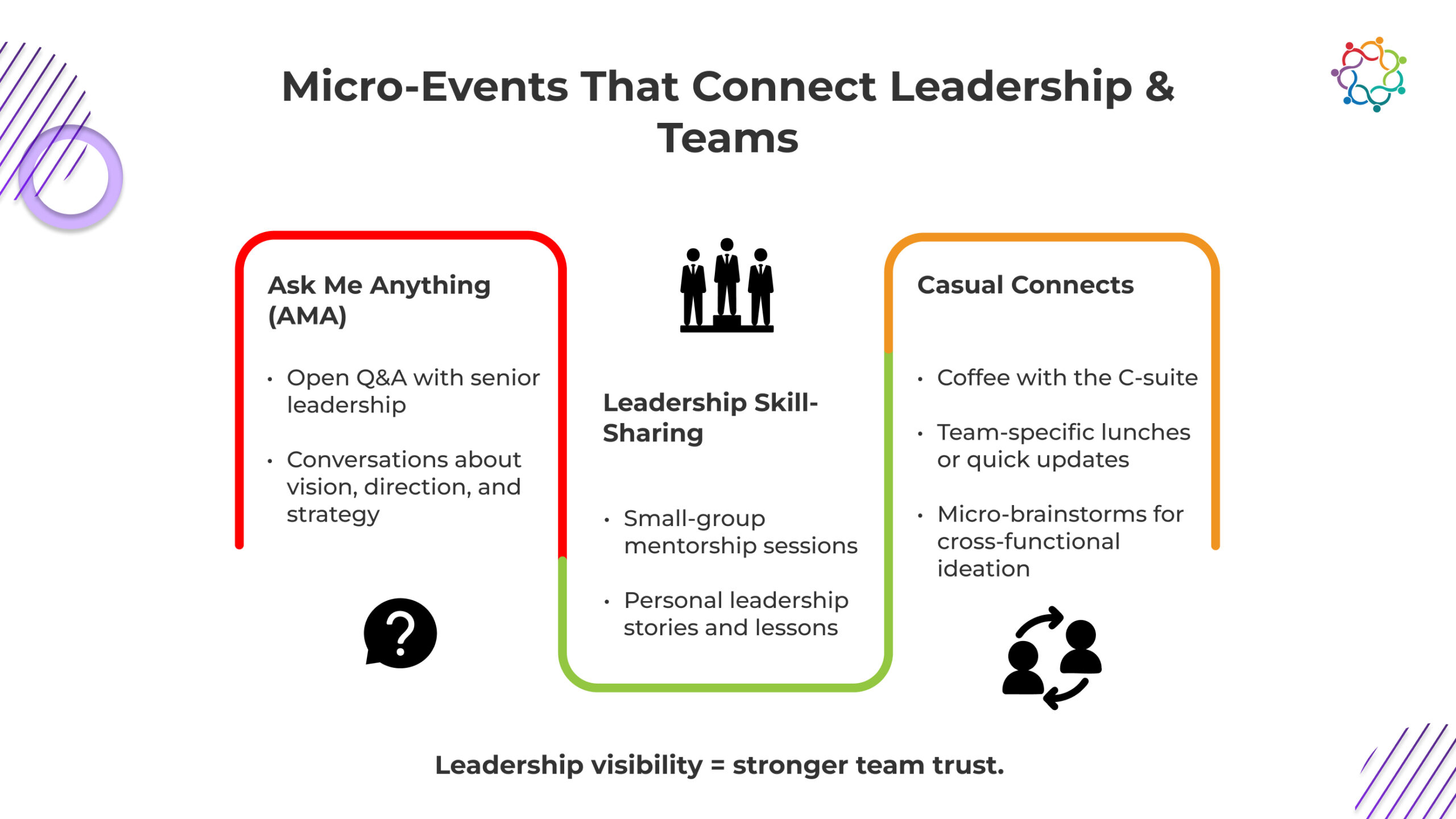
In 2025, micro events are more than just a trend, they’re an essential tool for boosting engagement, fostering collaboration, and nurturing the creative potential within your teams. Whether it’s for team building, professional development, wellness, or sparking innovation, these small-scale corporate events are incredibly versatile and can fit seamlessly into the fabric of your company’s culture.
The beauty of micro events is their ability to be customized to your team’s needs, size, and goals. By implementing even just a few of the creative corporate events shared in this blog, you’ll not only enhance employee engagement but also create lasting memories and connections that drive success across your organization.
The key is to keep it simple, fun, and aligned with your company values. As we move further into 2025, corporate micro events will continue to shape how businesses build a resilient, innovative, and connected workforce. So, which micro event idea will you try first?
For years, the success of B2B events has been measured by a single metric: leads. The number of new contacts scanned at the booth or registrations collected from a webinar have long been used as a shorthand for ROI. But here’s the problem, leads alone don’t equal revenue.
The reality is, events do much more than just fill the top of your funnel. When strategically planned, they can influence every stage of the revenue pipeline, from creating awareness to accelerating decision-making, deepening customer relationships, and unlocking expansion opportunities.
In today’s complex B2B landscape, where trust, timing, and relationship depth matter more than ever, it’s time we reframe how we view the role of events. This blog dives into how events, when aligned with your revenue goals, serve as powerful tools to drive pipeline velocity and impact revenue far beyond the initial lead capture.
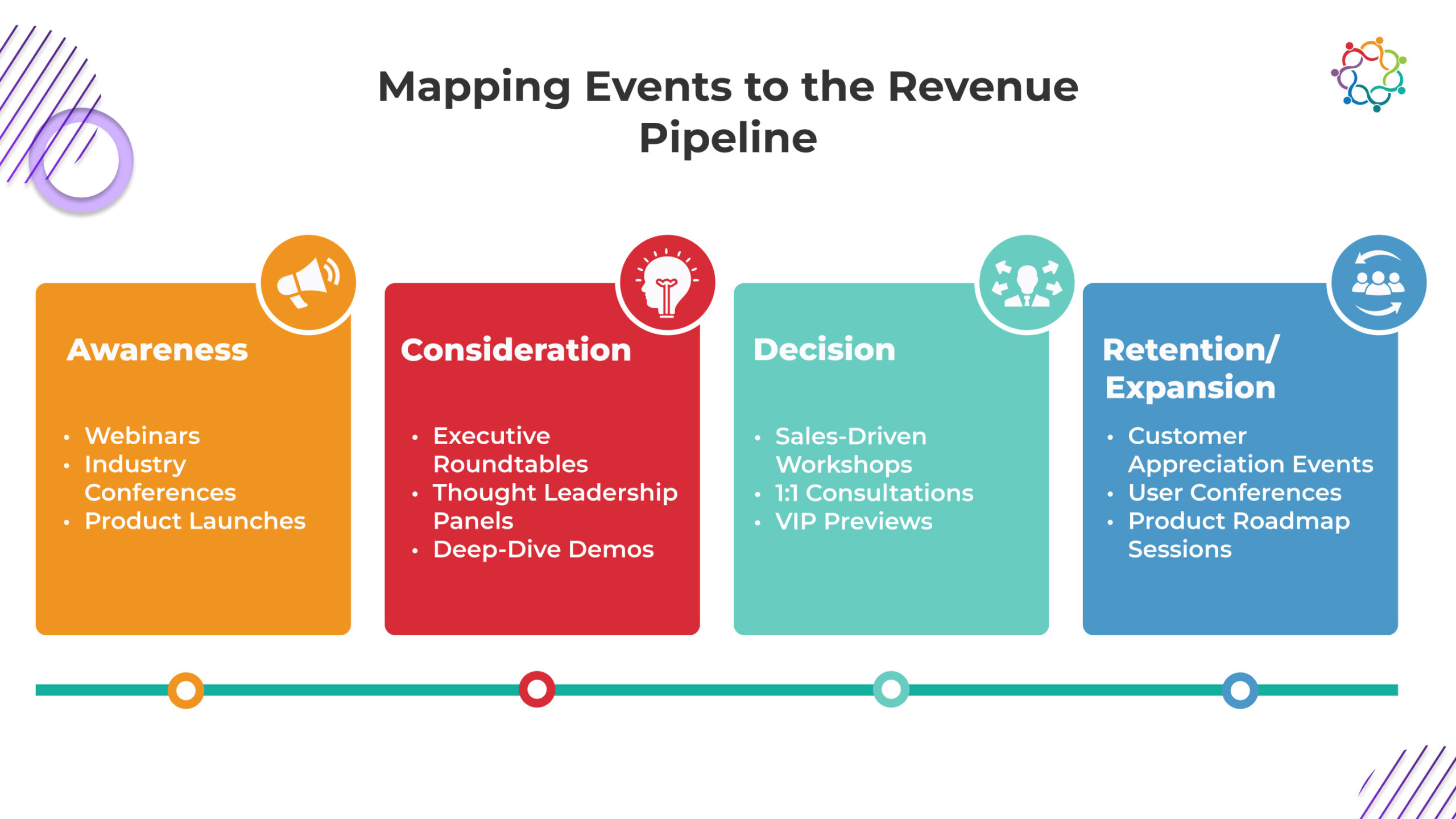
To understand the true value of events, we first need to zoom out and look at the full revenue pipeline. Typically, this pipeline includes stages like:
Now, imagine layering event types across this journey:
Unlike static content, events bring immediacy, interactivity, and human connection to your pipeline. They shorten sales cycles, unearth high-intent opportunities, and foster the kind of brand affinity that purely digital interactions often struggle to build.
By mapping your event strategy to the revenue pipeline, you shift the focus from collecting names to driving real business impact.
Once a prospect enters the consideration stage, the stakes get higher. They’re no longer just browsing,they’re actively evaluating solutions, comparing vendors, and looking for signals of trust, credibility, and value. This is where strategic events shine by accelerating the journey from interest to intent.
Events allow for live, two-way engagement that deepens connections in a way passive content can’t. Whether it’s through interactive formats like Q&A sessions, group discussions, or networking lounges, events provide the space for prospects to engage with your team and brand on a human level.
Personalized experiences, such as tailored breakout rooms, industry-specific tracks, or curated attendee groups, foster a sense of belonging and relevance. These moments build emotional rapport and trust, which are critical drivers in high-consideration B2B deals.
When your brand hosts or contributes to panel discussions, keynotes, or workshops, it positions your team as subject matter experts. Thought leadership content delivered live not only educates your audience but also signals confidence and authority.
Strategic use of customer success stories, product walkthroughs, or expert-led sessions at events can differentiate your offering from the competition and create an aura of trustworthiness that no sales deck alone can replicate.
Events are a prime opportunity to deliver information that goes beyond what’s publicly available. From sneak peeks into your product roadmap to deep-dive case studies and industry research, exclusive content shared in a live format increases its perceived value.
It also creates a sense of urgency, prospects feel they’re gaining access to privileged insights, which strengthens their connection to your brand and encourages quicker action.
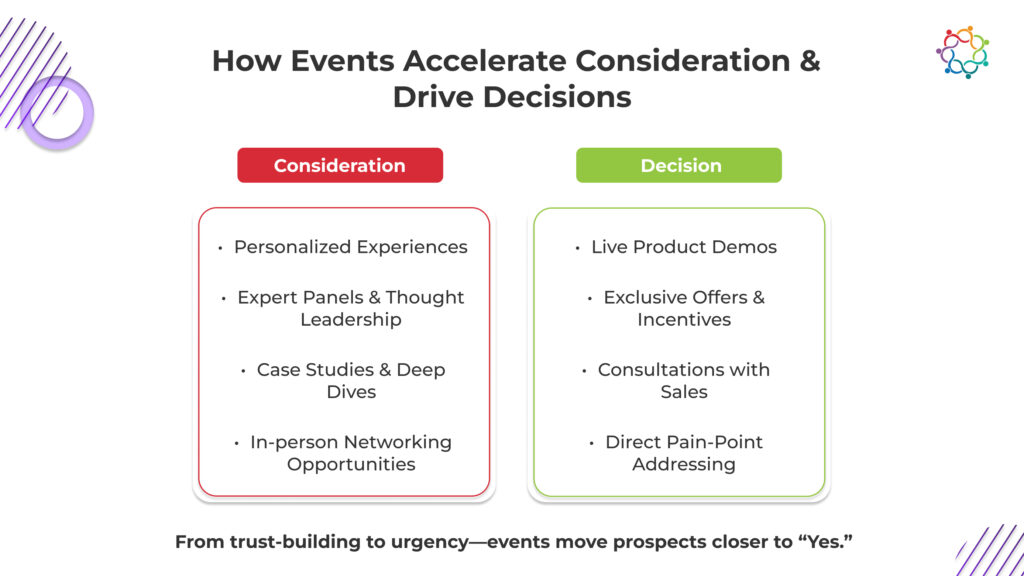
By strategically designing events to offer personalized engagement, thought leadership, and exclusive value, you transform the consideration stage into a powerful acceleration point in your pipeline. Events don’t just nurture interest, they convert it into buying intent.
By the time prospects reach the decision stage of your revenue pipeline, they’ve done their research. Now they’re looking for validation, confidence, and the right solution to meet their needs. This is where events can move the needle, not by generating leads, but by closing deals.
Strategically structured events can shorten the sales cycle, surface high-intent opportunities, and even convert on-site when aligned with sales efforts. Here’s how:
One of the most overlooked revenue opportunities at events is enabling intentional, sales-led interactions. Whether it’s through scheduled one-on-one meetings, dedicated consultation booths, or informal networking spaces, these in-person (or virtual) conversations give sales reps the chance to:
Event participation itself acts as a qualification marker, someone who shows up, engages in sessions, and speaks with your team is far more likely to be in-market than a passive lead from a landing page.
What’s working today:
Many revenue teams now coordinate on-site sales pods, mini teams equipped with tailored pitches, demo stations, and content relevant to the prospects attending. These teams don’t just collect contacts, they engage, qualify, and even set follow-up meetings before the event ends.
Events offer a unique opportunity to demonstrate your product in action,live, in context, and tailored to the prospect’s pain points.
This hands-on format increases retention and comprehension, while also making the solution feel more tangible and attainable.
Why it works: According to event marketing research, product demos presented in-person or via immersive sessions are 34% more likely to result in follow-up sales engagement than demos shared via email or landing pages.
Events create a moment in time,a window of heightened excitement and engagement. Smart marketers and sales teams capitalize on this by introducing event-specific offers that encourage fast action.
Examples include:
This approach works because it pairs emotional momentum with a practical incentive, pushing undecided prospects to take the next step.
Events are more than marketing showcases,they’re revenue conversion points. By enabling direct sales conversations, offering hands-on product experiences, and creating time-sensitive offers, events become high-impact environments for closing deals. When sales and event teams align around this intent, events move from being cost centers to true revenue drivers.
While many organizations focus heavily on using events to acquire new leads, some of the most significant revenue gains happen after the deal is closed. Events play a powerful role in deepening customer relationships, increasing satisfaction, and opening doors to upsell and cross-sell opportunities.
Here’s how strategic events can strengthen your post-sale pipeline:
Bringing customers together through exclusive user conferences, appreciation dinners, or regional meetups helps reinforce the value of your partnership beyond the transactional.
These events:
For B2B companies especially, fostering a sense of community and belonging is a long-term differentiator that reduces churn and increases brand affinity.
Example: SaaS companies like HubSpot and Salesforce invest heavily in annual user conferences because they understand that loyal customers,when engaged and informed,stick around longer and spend more.
Customer-focused events provide a natural setting to introduce new offerings, demonstrate value-add features, and identify expansion opportunities.
Tactics include:
These aren’t just sales pitches, they’re high-value conversations with an audience that already trusts your solution.
Pro tip: Equip your customer success and account managers with tailored talking points and collateral based on the attendee list and existing contracts. Expansion often starts with the right conversation at the right moment.
Events are one of the best places to spot, elevate, and activate brand champions. When customers are invited to speak on panels, share success stories, or network with peers, they’re more likely to:
Encouraging peer-to-peer engagement also increases trust among attendees, hearing value from a fellow user carries more weight than hearing it from a sales rep.
Real impact: Companies that consistently feature customers in event programming report higher NPS scores and referral rates.
Customer-focused events are not just retention tactics,they’re growth accelerators. When done well, they turn satisfied users into loyal advocates, uncover upsell opportunities, and solidify long-term revenue relationships. If you’re not leveraging events to deepen post-sale engagement, you’re leaving pipeline potential untapped.
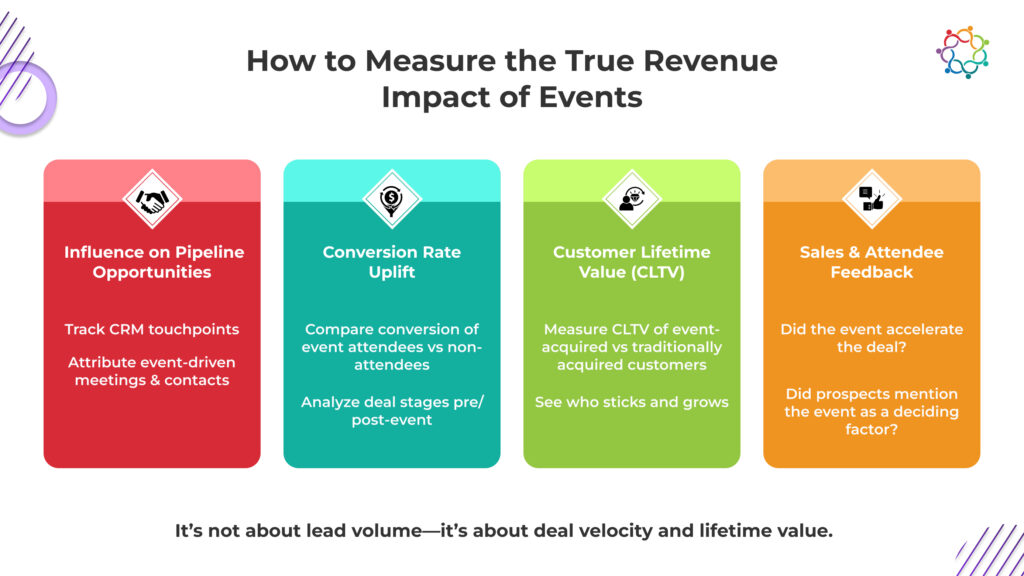
Most event reports stop at registration numbers and MQLs. But if your goal is pipeline growth, your metrics should tell a deeper story,one that shows how events contribute to actual revenue outcomes.
Here are key ways to measure that impact:
Integrate your event platform with your CRM or revenue operations system (e.g., Salesforce, HubSpot) to directly associate attendees with open opportunities. This helps you:
Example: If 30% of your closed-won deals in Q2 attended a March product webinar, that’s a clear indicator of impact,even if they weren’t new leads.
Beyond registrations, ask: Do people who attend your events convert at a higher rate?
Segment your pipeline and compare:
Often, you’ll find that engaged event participants move faster and convert at higher rates due to the relationship-building and trust developed during events.
Take a long view by analyzing whether customers who attend events:
This is especially valuable for subscription-based businesses or high-LTV accounts, where event engagement correlates directly with retention and growth.
Sometimes, data alone can’t capture the nuance. Make it a practice to:
These insights provide context for the numbers and help refine your event strategy over time.To prove the true ROI of your events, you need to look beyond surface-level metrics. When you connect event participation to revenue outcomes,pipeline influence, faster deal cycles, higher retention, you unlock a more strategic role for events in your go-to-market engine.
Embracing the Full Revenue Potential of Strategic Events
Events are far more than flashy brand moments or lead-generation campaigns. When strategically designed and aligned with your revenue goals, they become powerful levers across the entire pipeline, from building awareness to accelerating deals and deepening customer loyalty.
By rethinking events not as isolated marketing activities, but as revenue-driving touchpoints, organizations can unlock better ROI, tighter sales alignment, and more meaningful customer relationships.
And to truly make this shift, you need the right tools.
That’s where Samaaro comes in.
Samaaro is more than just an event platform, it’s a revenue enablement tool built for event marketers and revenue teams who want measurable impact. From CRM-integrated registration flows and real-time engagement analytics to lead scoring, sales enablement features, and post-event feedback tools, Samaaro helps you connect every event interaction to real pipeline outcomes.
So, if you’re ready to move beyond vanity metrics and turn your events into revenue engines, it’s time to rethink your strategy,and your toolkit.
Strategic events drive more than leads. They drive growth. Let Samaaro help you prove it.
In 2025, event planning is more complex, and more exciting, than ever. With rising attendee expectations, hybrid formats giving way to deeply personalized in-person experiences, and ever-tightening timelines, event professionals are increasingly turning to technology to stay ahead. But with hundreds of platforms now on the market, choosing the right software stack is no longer a matter of convenience, it’s a strategic imperative.
Having the right tools can make or break an event. Whether you’re organizing a 500-person conference or a high-impact product launch, efficient operations, seamless communication, and meaningful engagement all depend on smart software choices. From project management and registration systems to on-site check-ins and real-time analytics, this guide walks you through the essential platforms event planners should consider for 2025.
We’ll explore tools across five core categories:
Let’s dive into the event planner’s digital toolkit, and discover how to equip your team for success in the year ahead.
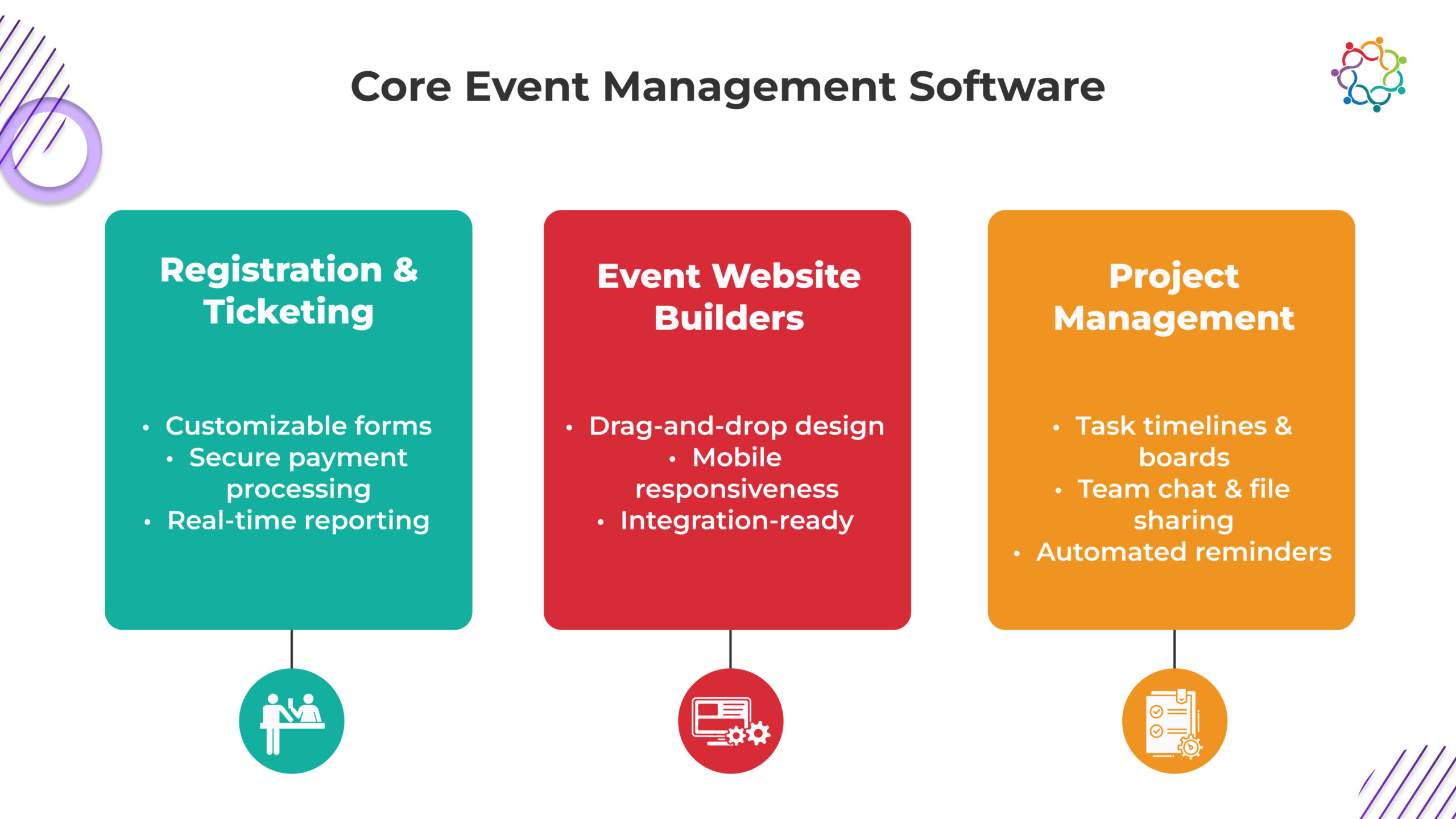
Event planning in 2025 demands powerful, integrated software that can manage every aspect of your event from start to finish. Core event management tools, such as registration and ticketing platforms, website builders, and project management tools, are critical to the success of any event. These tools not only help streamline operations but also improve attendee experience and enhance team collaboration. Here’s a closer look at each of these essential tools:
Your registration and ticketing platform is a vital touchpoint for your attendees, handling everything from ticket sales to attendee data. The right platform ensures a smooth experience for both you and your participants.
A professional and informative event website is essential for promoting your event and handling attendee registration.
Effective project management ensures tasks are completed on time and the event runs smoothly, all while maintaining clear communication with your team.
Choosing the right event management tools is essential for success. While platforms like Eventbrite, Webflow, and Asana provide specific functionalities, Samaaro offers an integrated, all-in-one solution. From registration and website creation to project management and attendee engagement, Samaaro ensures your event runs smoothly while providing the flexibility and efficiency needed in 2025’s fast-paced event landscape.
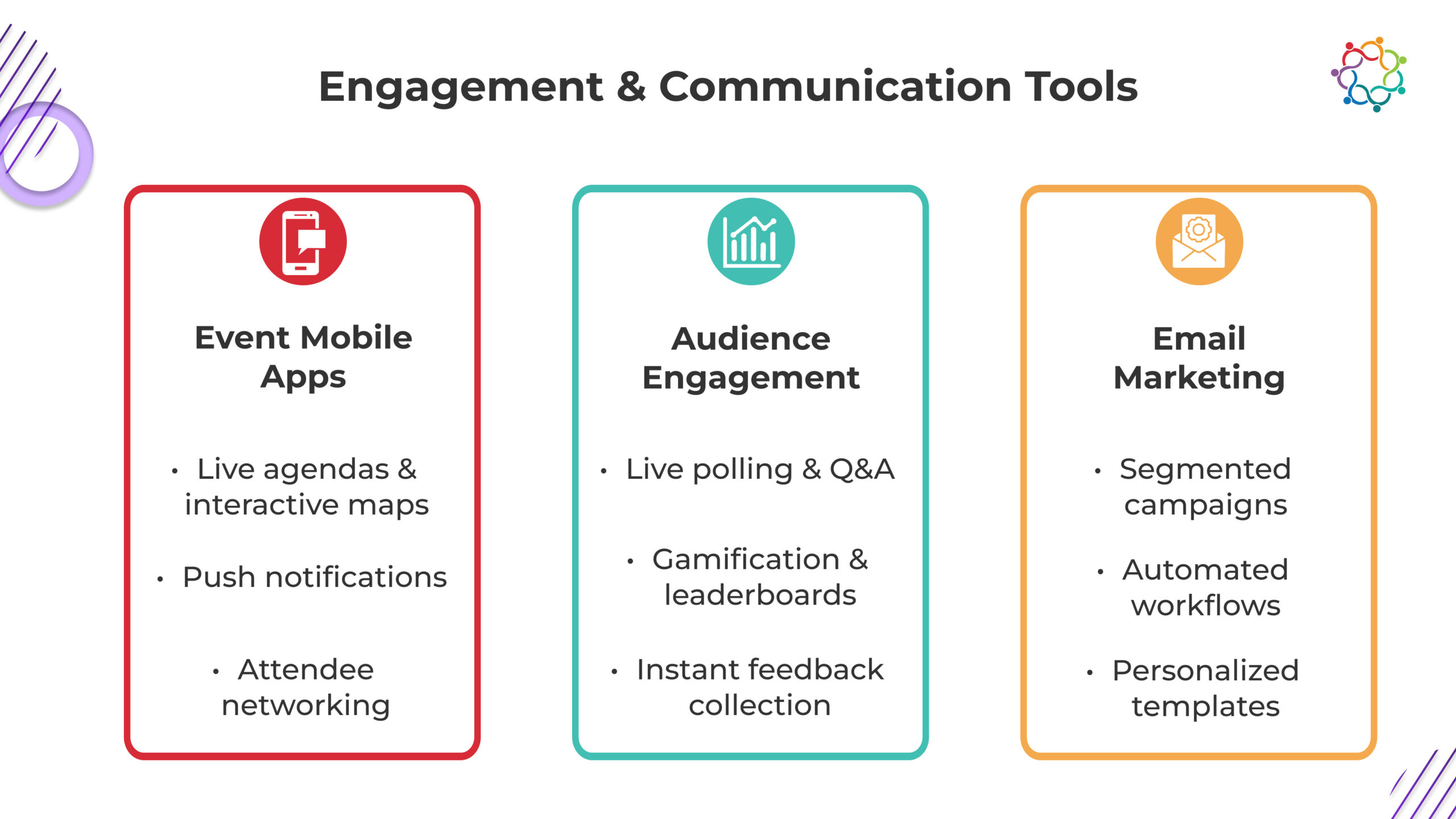
The attendee experience is at the heart of any successful event. As event planners, offering a seamless, interactive, and engaging experience ensures that your attendees stay connected, informed, and actively participate throughout the event. In 2025, tools that enhance attendee engagement are not just a luxury, they’re a necessity.
Benefits for Attendees: Event mobile apps are becoming essential for modern events. They offer attendees easy access to event details, help them navigate the venue, and connect them with other attendees. With a mobile app, attendees can stay updated with real-time notifications, ensuring they never miss an important session, speaker, or activity.
Boosting Participation: Engaging your audience during an event is essential for maximizing participation and creating lasting connections. Platforms that facilitate live polling, Q&A sessions, and audience interaction help keep attendees involved and excited.
Importance for Pre-event Promotion and Post-event Follow-up: Email marketing remains one of the most powerful tools for event promotion. From pre-event promotions and reminders to post-event follow-up, a strong email marketing strategy helps you maintain communication with attendees, drive registration, and ensure continued engagement even after the event ends.
Creating a memorable attendee experience in 2025 requires the right engagement and communication tools. With Samaaro‘s mobile app, audience engagement features, and email marketing integration, event planners can deliver a seamless, interactive, and personalized event experience. By keeping attendees engaged before, during, and after the event, Samaaro empowers you to create lasting impressions and build stronger connections with your audience.
When it comes to on-site event management, smooth operations are essential to creating a positive experience for attendees, exhibitors, and speakers alike. Effective tools can streamline logistics, minimize delays, and ensure that every detail runs according to plan. In 2025, a well-executed event not only relies on great content and engagement but also on the seamless integration of various operational tools that support every part of the event.
Streamlining Attendee Arrival: The check-in process sets the tone for the entire event experience. A quick and efficient check-in not only makes a great first impression but also reduces wait times and frustration, allowing attendees to feel welcomed right from the start.
Seamless Presentations and Technical Management: Managing audiovisual (AV) needs is a vital part of delivering an impactful event. Whether it’s for virtual components, in-person presentations, or hybrid formats, having the right AV and technical support tools ensures that everything runs smoothly and without technical hitches.
On-site execution is critical for creating a smooth, seamless experience for both your team and your attendees. Tools like Samaaro’s check-in and badge printing system, along with its AV and technical support management, allow event planners to keep operations running smoothly, minimize delays, and ensure that all logistics are handled efficiently. With these integrated tools, event organizers can focus more on creating value for attendees and less on troubleshooting technical issues.
In the modern world of event planning, simply hosting an event is no longer enough. Measuring and analyzing your event’s success is crucial for continuous improvement and ensuring that your objectives, whether they are lead generation, engagement, or brand awareness, are being met. Event data provides valuable insights into attendee behavior, engagement levels, and the overall impact of your event, which can inform future strategies and decisions.
Effective data analysis and reporting tools can give event planners a clear picture of their event’s performance, providing them with actionable insights that drive better decision-making. Here are the critical tools and platforms that will help you measure your event’s success in 2025.
Tracking Key Event Metrics: Event analytics dashboards have become the cornerstone for tracking performance metrics in real time. These dashboards allow event planners to monitor essential data points like registration numbers, attendee behavior, engagement levels, and session attendance, helping teams stay on top of performance throughout the event.
How to Use Data to Inform Future Event Planning: By tracking these key metrics, event planners can create a comprehensive post-event analysis report that informs decisions for future events. For example, if you notice a significant drop-off in registration at a certain point in your event, you can adjust your event scheduling or marketing approach for next time. Similarly, understanding which sessions generated the most engagement can help you optimize your content for future events.
Gathering Attendee Feedback for Continuous Improvement: After the event, gathering feedback from attendees is one of the best ways to assess their experience and determine how well your event met its goals. Attendee surveys provide qualitative and quantitative data that can reveal what worked well and where improvements are needed. With the right feedback tools, you can gather meaningful insights that can help you refine your event strategies.
Effective data analysis and reporting are key to understanding the success of your event and ensuring continuous improvement for future events. With tools like Samaaro’s integrated analytics dashboards and feedback platforms, event planners can gain deep insights into attendee behavior, engagement, and satisfaction. These insights enable informed decision-making, optimizing event strategies for maximum impact. In 2025, harnessing the power of data will not only improve your event’s performance but will also help you create more personalized, engaging experiences for your audience.
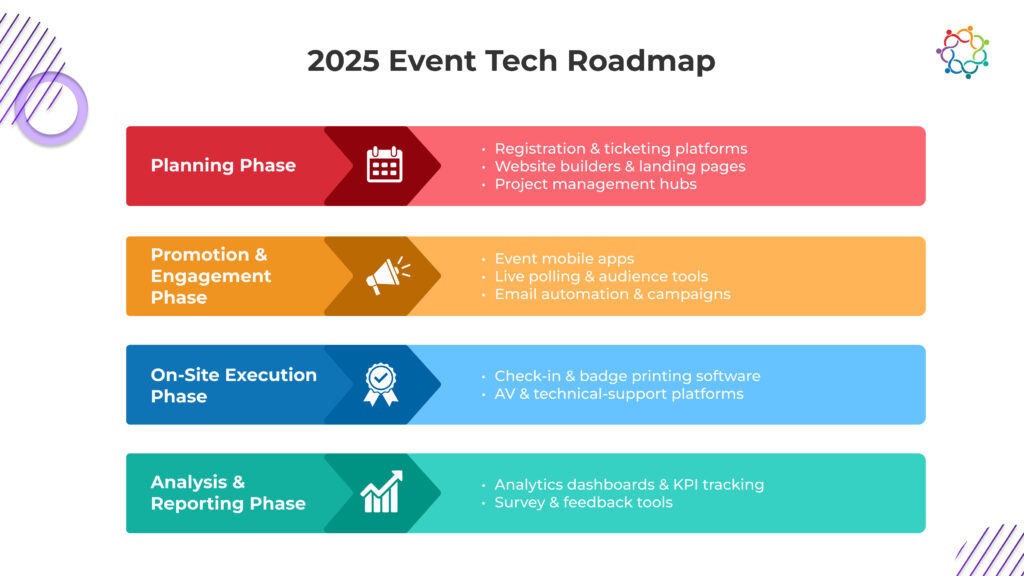
As we move further into 2025, technology is rapidly evolving, bringing new opportunities and tools to the event planning industry. Staying ahead of these advancements is essential for event planners who want to stay competitive and deliver cutting-edge experiences for their attendees. Here are some of the emerging technologies that are shaping the future of event planning:
Artificial Intelligence (AI) has the potential to revolutionize the way events are planned and executed. AI-driven tools can help automate administrative tasks, enhance attendee experiences, and provide valuable data insights that would have been impossible to gather manually.
Virtual Reality (VR) and Augmented Reality (AR) technologies are rapidly gaining traction in the events space, especially for creating immersive and engaging experiences.
Blockchain technology is making waves in various industries, and event planning is no exception. Blockchain can enhance ticketing processes by providing secure, tamper-proof digital tickets that eliminate fraud and counterfeit issues.
Wearable devices and IoT are opening up new ways to track attendee engagement and provide personalized experiences. Devices such as smart badges or wristbands can collect data on attendee movements, interactions, and preferences during an event.
These emerging technologies are just the beginning. As event professionals continue to experiment and innovate, we can expect even more advanced tools and platforms to enhance attendee experiences, streamline planning processes, and provide deeper insights into event performance. Keeping an eye on these technologies will ensure that your events stay at the forefront of innovation in 2025 and beyond.
As we look ahead to 2025, event planning is becoming more complex and technology-driven, but also more exciting and full of opportunities. By leveraging the right event planning software and platforms, you can ensure that your events are well-organized, engaging, and impactful. The essential tools—from registration and ticketing platforms to data analysis and event engagement technologies—are crucial to delivering a seamless and successful experience for both planners and attendees.
For event planners, the key to success in 2025 lies in adopting technologies that not only simplify the planning process but also provide data-driven insights and opportunities for enhancing attendee experiences. Whether it’s a robust project management tool like Samaaro, a cutting-edge mobile app, or AI-powered solutions, the right technology can streamline your workflow and help you execute events that leave a lasting impact.
As the event industry evolves, so should your toolkit. At Samaaro, we are committed to empowering event planners with the latest technology to manage, engage, and measure their events. Our all-in-one platform provides everything you need—from seamless registration and ticketing to advanced analytics and personalized attendee experiences. In 2025, equip yourself with the best tools to stay ahead of the curve and deliver truly exceptional events.
By staying updated on emerging technologies, exploring new tools, and continuously optimizing your processes, you’ll be well on your way to event planning success in the years to come.
In a world overflowing with digital noise, getting the right people to notice, and register for, your event is a challenge. But here’s the good news: LinkedIn users are 6x more likely to engage with content related to their profession than users on other platforms. That makes LinkedIn not just another social media channel, but the go-to destination for promoting your event to a professional, purpose-driven audience.
In this guide, we’ll walk you through a comprehensive framework for using LinkedIn to drive real outcomes, from awareness and sign-ups to conversations and community building. Whether you’re organizing a major conference, a targeted webinar, or a niche roundtable, this guide will help you maximize your event’s impact on LinkedIn.
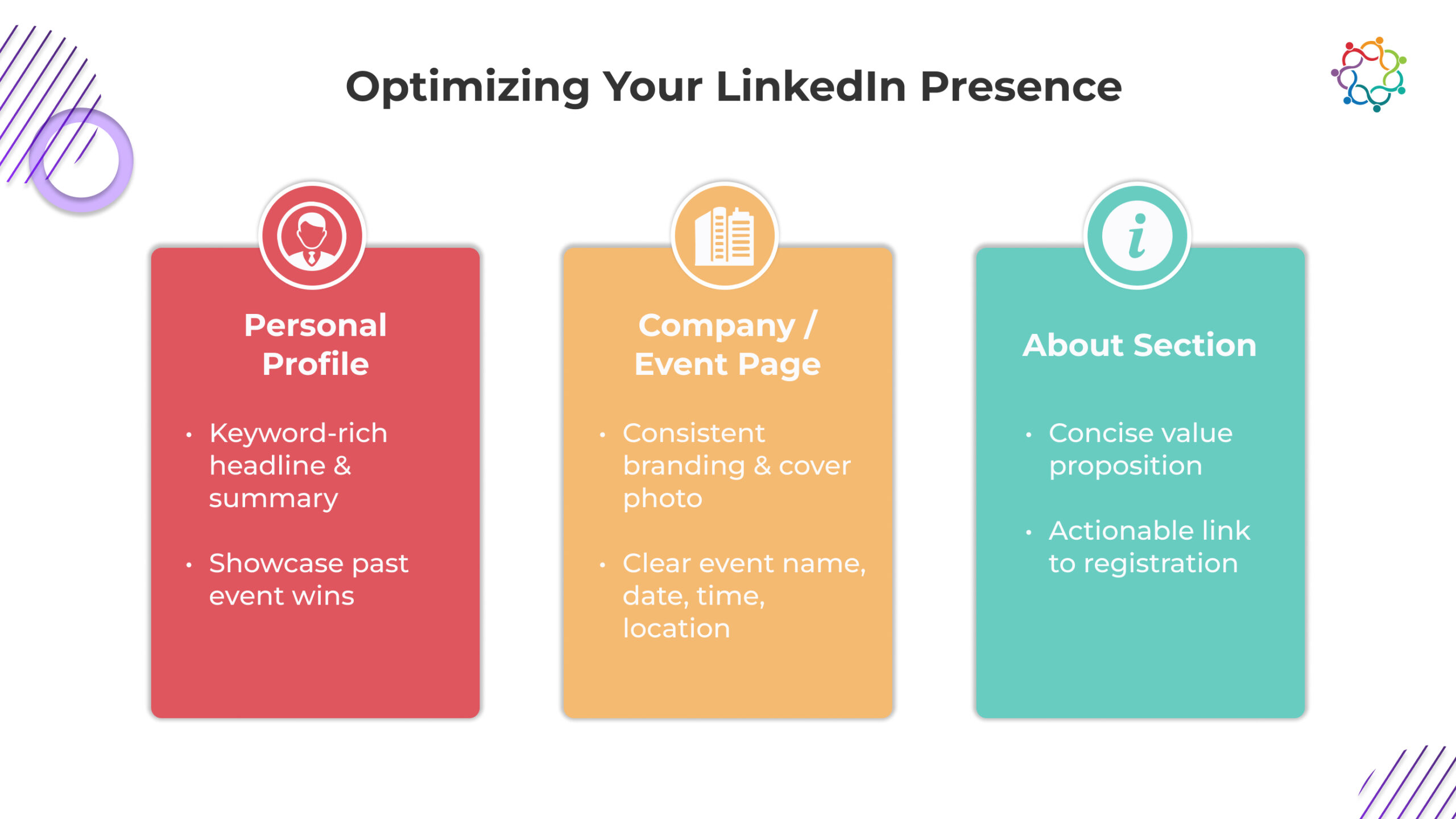
Before you start promoting your event, it’s crucial to get your house in order. First impressions matter, and your LinkedIn profile and company page are often the first touchpoints for potential attendees.
If you’re a key organizer, speaker, or promoter, your personal profile is a powerful tool. Here’s how to optimize it:
Whether you’re promoting through your existing company page or creating a dedicated event page, here’s how to make it effective:
By optimizing these foundational elements, you’re setting the stage for everything that follows, from teaser content to paid promotions. It’s about building trust and making it easy for potential attendees to understand the what, why, and how of your event in seconds.
Once your profile and company page are optimized, it’s time to start building visibility and driving interest through compelling content. LinkedIn’s algorithm favors consistency, relevance, and engagement, so your goal is to show up regularly with posts that spark conversation, offer value, and prompt action.
Begin your content strategy by creating excitement around the event before diving into specifics. Teasers are meant to pique curiosity and build early momentum.
As the event date approaches, share content that educates and informs. The objective here is to answer the practical questions potential attendees may have.
LinkedIn is no longer just text-based, visual storytelling helps you cut through the feed and deliver your message quickly.
Every post should serve a purpose, and for event marketing, that purpose is usually registration.
By layering your content, from teasers to logistics, you build a compelling narrative that informs, excites, and converts. Great content doesn’t just promote your event; it gives people a reason to care about it.
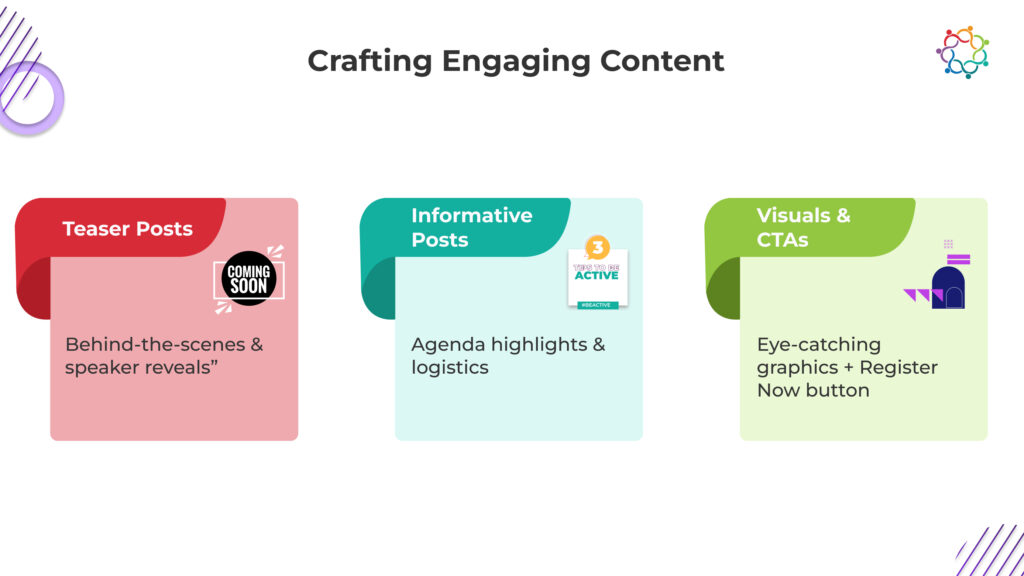
Publishing great content is just the beginning, how you amplify that content using LinkedIn’s built-in tools can dramatically increase your visibility, engagement, and registrations. LinkedIn offers a suite of features specifically designed to help you reach the right audience and convert interest into attendance.
Creating an official LinkedIn Event helps you centralize information, promote easily, and track engagement.
Long-form content offers the opportunity to go deeper and build credibility around your event’s value.
LinkedIn Groups are fertile ground for connecting with highly targeted, like-minded professionals.
Hashtags help surface your content to a wider, yet still relevant, audience beyond your followers.
When organic reach isn’t enough, LinkedIn’s paid promotion tools can help you zero in on high-intent professionals.
Often overlooked, direct outreach remains one of the most effective ways to drive registrations, especially for high-value or niche events.
By combining organic content with strategic use of LinkedIn’s features, like Events, Ads, and Messaging, you can drastically extend your event’s reach and make sure it lands in front of the people who matter most.
Creating content and promoting your event is only half the battle, true success comes from building genuine engagement and fostering a sense of community around your event. LinkedIn’s interactive features offer powerful ways to connect with your audience, encourage participation, and create momentum before, during, and even after the event.
Tip: Ensure strong lighting, stable internet, and a clean backdrop to maintain professionalism during live sessions.
Building a LinkedIn community around your event deepens engagement, turns attendees into advocates, and lays the foundation for long-term brand relationships.
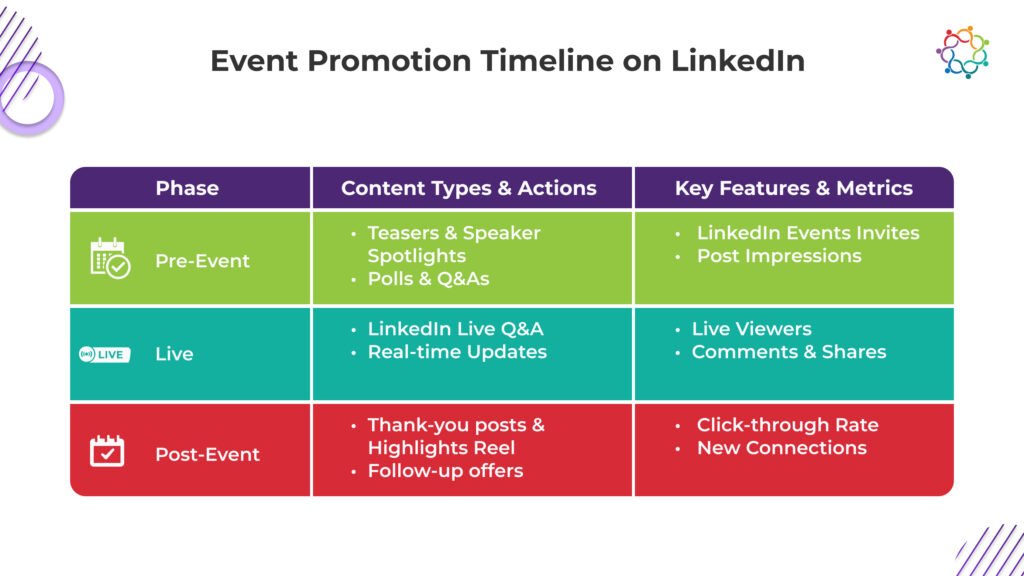
Once the content is out and the event is underway, the final piece is measurement. Tracking performance and analyzing LinkedIn-specific metrics ensures that your promotional efforts translate into real impact, and provides learnings for the next campaign.
Measurement turns guesswork into strategy. By tracking performance and optimizing your efforts, you ensure that each LinkedIn campaign drives smarter, more efficient event success.
LinkedIn isn’t just another social media platform – it’s a professional stage where your event can stand out, engage the right audience, and drive real business results. From optimizing your profile and crafting engaging content to leveraging features like LinkedIn Events, Live, and Ads, this platform offers a full-stack toolkit for impactful event promotion.
By building a community around your event and tracking the right metrics, you can continuously refine your strategy and turn LinkedIn into a high-performing marketing channel.
At Samaaro, we understand the value of strategic promotion in maximizing event ROI. That’s why our platform is built to integrate with your marketing efforts – helping you generate leads, capture feedback, and analyze performance in real time. Whether you’re planning a product showcase or a large-scale summit, Samaaro empowers you to deliver measurable results from promotion to post-event.
Ready to elevate your next event?
Let LinkedIn be your launchpad – and let Samaaro be your execution partner.
In recent years, the United Arab Emirates has emerged as a global hotspot for world-class events, ranging from international trade expos and technology conferences to sports tournaments and cultural festivals. This rapid rise isn’t accidental. It’s backed by national initiatives like the UAE Vision 2031, a robust tourism economy, and a business-friendly environment that invites brands from across the globe to engage with highly targeted and affluent audiences.
As the event ecosystem matures, sponsorship has evolved from simple brand visibility to something far more strategic. It’s no longer about just placing a logo on a banner or a booth. In today’s competitive landscape, event sponsorship in the UAE is a dynamic tool for forming strategic partnerships, collaborations where both sponsor and host work together to create mutual value.
In the context of events, a strategic partnership means moving beyond transactional sponsorships to co-created, goal-aligned collaborations. It involves brands and event organizers working hand-in-hand to deliver tailored experiences, activate targeted audiences, and achieve shared outcomes, whether that’s customer acquisition, brand elevation, or community engagement.
These partnerships aren’t just marketing plays, they’re long-term growth levers. And in a region like the UAE, where scale, innovation, and global attention intersect, the opportunities are significant for those who know how to craft them well.

The UAE’s events industry is in the midst of a golden era. Cities like Dubai and Abu Dhabi are leading the charge with ambitious investments in world-class infrastructure, hospitality, and connectivity, all of which support a vibrant events calendar.
Several macro factors are fueling this growth:
Whether it’s hosting the Global AI Summit or international music festivals, the UAE has positioned itself as a preferred destination for large-scale gatherings, and that creates a fertile ground for strategic sponsorships.
Event sponsorship in the UAE isn’t confined to just one domain. It spans across a range of high-growth sectors, each with unique audiences and brand alignment opportunities.
From GITEX Global to Arabian Travel Market, the UAE is home to some of the largest B2B expos in the world. These events are magnets for C-suite decision-makers, investors, and innovators, making them ideal grounds for tech companies, fintech players, and industry disruptors looking to establish credibility and generate leads.
The UAE is increasingly positioning itself as a regional sports hub, with global events like:
Sports sponsorships provide massive reach, international broadcast exposure, and premium on-site activations for lifestyle, luxury, and automotive brands.
From the Dubai Shopping Festival to Abu Dhabi Film Festival, cultural and entertainment events offer sponsors unique ways to emotionally connect with audiences. They’re ideal for FMCG brands, fashion retailers, and consumer tech firms aiming to enhance visibility among local and regional consumers.
These sectors reflect the diversity and vibrancy of the UAE’s event landscape, making it essential for sponsors to tailor their strategies based on the nature and audience of each event.
Strategic event sponsorships in the UAE go far beyond logo placements and booth space. When designed thoughtfully, they offer tangible value for both sponsors and event organizers. Here’s how:
UAE events often attract hyper-relevant audiences, from C-suite executives at global tech summits to culture-conscious consumers at lifestyle festivals. Sponsors benefit from:
For organizers, strong sponsorships enhance event credibility and experience quality, making the event more attractive for attendees and media alike.
Live events provide a rare opportunity for face-to-face engagement in a digital-first world. Sponsors can:
For hosts, sponsored activations increase attendee dwell time and enrich the overall experience, making the event more engaging and memorable.
Sponsorships aren’t confined to the event venue. They often generate rich content opportunities that extend value long after the event ends:
This digital layer multiplies ROI for both parties, especially in a content-hungry landscape like the UAE’s marketing ecosystem.
Understanding the regulatory environment is crucial for both local and international brands considering sponsorships in the UAE. Fortunately, the country has streamlined many of its policies to encourage foreign investment and brand participation in its events sector.
The Department of Tourism and Commerce Marketing (DTCM) in Dubai offers structured sponsorship schemes for events that align with the city’s branding and tourism goals.
For sponsors, events supported by DTCM often signal a level of quality and legitimacy, making them more attractive opportunities to associate with.
The UAE has made significant progress in liberalizing business laws to attract international sponsors and event organizers.
This regulatory clarity has made it easier, and more appealing, for international sponsors to participate in the UAE event market with confidence.

Not all sponsorships are created equal. The most impactful ones are the result of deliberate alignment, creative collaboration, and tailored execution. Here’s how to move from transactional deals to truly strategic partnerships.
Strategic sponsorships begin with shared purpose.
When brand and event narratives align, the impact is stronger and more memorable.
Gone are the days of one-size-fits-all sponsorship tiers. Today’s leading events offer flexible, creative packages that reflect each sponsor’s goals.
Sponsors should seek involvement in package design, rather than settling for predefined benefits. Co-creation ensures relevance and maximizes ROI.
In the UAE, where event experiences often blend the physical with the digital, a well-executed activation can deliver long-lasting impact.
By designing immersive and shareable experiences, sponsors not only elevate their brand presence but also contribute to a more memorable event environment.

In a data-conscious landscape, the success of sponsorships must be quantifiable. While brand equity and awareness are important, sponsors and organizers alike need clear metrics to evaluate performance and justify investment.
Before the event begins, focus on awareness and anticipation:
Setting benchmarks early helps both parties evaluate whether the sponsorship is set up for success.
The event itself is rich with opportunities to capture real-time engagement:
Real-time dashboards or mobile apps can help sponsors and hosts track these metrics live and adjust tactics if needed.
After the event, the focus shifts to outcomes and long-term impact:
This phase is critical, not only for reporting but also for iterating and improving future sponsorship efforts. A data-rich debrief sets the foundation for repeat, long-term partnerships.
As the UAE’s sponsorship landscape becomes more competitive, simply signing a contract is no longer enough. Success hinges on early planning, transparency, and agility. Here are some tried-and-true practices to keep both sponsors and organizers aligned and effective:
Strategic partnerships are not just about short-term visibility, they’re about long-term brand alignment and measurable value.
The UAE is not just a regional events hub, it’s a global stage for high-impact sponsorships. With world-class infrastructure, government support, and an increasingly sophisticated audience, the region offers unmatched opportunities for sponsors and event organizers to build lasting, value-driven partnerships.
By aligning brand values, customizing sponsorship packages, leveraging technology, and committing to measurement, brands can do more than just show up, they can show impact. Organizers, meanwhile, can transform their events into platforms that drive commercial success and thought leadership for everyone involved.
This is where platforms like Samaaro come in.
Samaaro empowers event organizers to streamline sponsorship management, from pre-event planning to post-event reporting. With integrated tools for branding, lead capture, content distribution, and performance tracking, Samaaro helps both sponsors and hosts create, manage, and measure strategic partnerships with precision.
Whether you’re hosting or sponsoring, now’s the time to reimagine what strategic sponsorship looks like in the UAE, and Samaaro is here to help make that vision a reality.
According to the Sales Enablement Collective, organizations with a defined sales enablement function achieve a 49% higher win rate on forecasted deals. Meanwhile, 47% of event marketers say in-person events deliver the highest ROI of any channel, yet many companies still treat events and sales follow-up as separate silos, leaving revenue on the table.
Sales enablement is the strategic, ongoing process of equipping sales teams with the content, guidance, training, and tools they need to engage buyers effectively and close deals faster.
Event marketing is the experiential promotion of a brand, service, or product through memorable live or virtual events designed to engage audiences, foster relationships, and drive conversions.
When sales enablement and event marketing unite under a shared strategy, organizations can amplify ROI, improve lead quality, and accelerate sales velocity.
We’ll explore:
At their core, both sales enablement and event marketing strive toward the same overarching goals: accelerating the sales pipeline, deepening engagement with high-value accounts, and driving revenue growth. When these functions operate in silos, the impact of their efforts is often diluted. However, when aligned, the results can be transformative, organizations with strong sales and marketing alignment grow revenue 32% faster and achieve 36% higher customer retention compared to those without alignment.
Events, whether trade shows, roadshows, or executive roundtables, create rich opportunities for marketing and sales to work in concert. Marketing sets the stage by generating interest and delivering value-driven experiences. Sales, equipped with timely insights and content, can then build on this momentum with targeted conversations that move prospects swiftly through the funnel. When both teams share the same goals, whether that’s generating a certain number of qualified leads, booking meetings, or closing deals sourced from an event, they can align tactics, prioritize resources more effectively, and create a seamless prospect experience that maximizes conversion potential.
Traditionally, marketing and sales operate at different stages of the buyer journey, and often in different communication modes. Marketing typically focuses on one-to-many engagement, casting a wide net to attract and nurture prospects through content, campaigns, and events. Sales, meanwhile, executes one-to-one outreach, building personalized relationships with key stakeholders to convert interest into purchase decisions.
Without intentional collaboration, this division creates gaps: marketing may deliver leads that sales deem “unqualified,” or sales may miss opportunities to leverage marketing-driven content in their conversations.
Integrating sales enablement into event marketing breaks down these barriers:
When insights flow both ways, event experiences become not just marketing exercises, but strategic sales accelerators.
To fully capitalize on the synergy between sales enablement and event marketing, organizations must move beyond ad-hoc collaboration and develop a unified go-to-market charter. This charter outlines how marketing and sales will work together, before, during, and after events, to drive shared business outcomes.
Key elements of a unified charter include:
By owning joint KPIs, both teams are incentivized to collaborate continuously and measure success through the same lens.
By formalizing collaboration through a charter, marketing and sales transition from operating in parallel to working in true partnership, creating an integrated, high-performing revenue engine that fully leverages the power of events.

Effectively integrating sales enablement into event marketing isn’t just about working together, it’s about building a system that supports the full journey of a lead, from first interaction at the event to closed deal. Here’s how to build that system across every phase:
Sales Input into Event Planning
Sales teams are on the front lines, constantly interacting with prospects and hearing firsthand their needs, challenges, and objections. Before any event, it’s crucial to tap into this intelligence. Organize collaborative workshops where sales can share updated buyer persona insights, the latest pain points emerging in conversations, and critical objections prospects raise. This information should directly inform the event’s session topics, speaker selection, messaging frameworks, and booth materials. When event content mirrors real-world buyer concerns, it’s far more likely to drive engagement and pipeline impact.
Develop Event-Specific Sales Assets
Generic brochures and one-size-fits-all presentations won’t cut it for strategic events. Ahead of each event, create custom talking points, FAQ sheets, product demos, and quick-reference materials that reflect the event theme and audience’s priorities. Design digital leave-behinds (such as product one-pagers, customer success stories, or demo videos) that sales can quickly send after conversations. These resources should act as bridges between the excitement of the event and the deeper buying discussions that happen afterward.
Train Sales Reps on Event Goals
Your sales team should never arrive at an event unsure of what success looks like. Host pre-event workshops or virtual briefings to align everyone on key goals, such as the number of qualified conversations or meetings booked. Define attendee segments (e.g., VIP prospects, target accounts) and clarify lead qualification criteria. Role-play common booth scenarios to help reps practice introductions, qualifying questions, and smooth transitions into follow-up conversations. The better prepared the sales team is, the more impactful every attendee interaction will be.
Pre-Event Outreach
Waiting until prospects walk up to the booth is a missed opportunity. Arm your sales teams with pre-written email templates and LinkedIn messaging scripts that they can personalize and send to registered attendees before the event. Encouraging reps to book meetings in advance not only increases on-site engagement but also boosts the overall return on investment by focusing efforts on high-value prospects. Personalized pre-event outreach can significantly improve booth traffic quality and shorten post-event sales cycles.

Real-Time Content Sharing
Events are dynamic, and plans often evolve on the ground. Product updates, schedule changes, or new talking points can arise. Create real-time communication channels, like a dedicated Slack workspace or a mobile app, so marketing can instantly push updates to the sales team. This ensures everyone is delivering the most current information during conversations with prospects.
Coordinated Engagement Roles
Clearly define roles and responsibilities for the sales and marketing teams before the event starts. Assign who will manage demos, who will handle meeting bookings, who will be responsible for scanning badges, and who will collect qualitative feedback. This division of labor prevents confusion, ensures no opportunity is missed, and creates a seamless experience for attendees moving through the booth or event space.
Seamless Lead Capture and Qualification
Forget business cards and manual note-taking. Implement digital lead capture tools like QR code scanning, mobile forms, or badge scanning apps that sync directly with your CRM system. Design your lead capture forms to include key qualification questions (such as budget, timeline, and decision-making authority) so sales reps can prioritize follow-up efforts immediately after the event. The goal is to achieve 100% lead data capture, clean, complete, and actionable, without burdening the onsite team with administrative tasks.
Event Content in Sales Conversations
Leverage event programming to enrich sales conversations. Equip your reps with strategies to reference keynote sessions, panel discussions, or workshops when speaking to prospects. For example, a rep might say, “As you heard in the opening keynote, digital transformation is reshaping procurement, let me show you how our platform directly addresses that shift.” This positions your team as knowledgeable and aligned with industry trends, enhancing credibility.

Prompt, Personalized Follow-Up
The first 48 hours after an event are critical. Leads are warm, memories are fresh, and competitors are also reaching out. Provide your sales reps with personalized follow-up toolkits, pre-approved email templates, session recordings, key presentation decks, and follow-up guides tailored to attendee interactions. Personalization is key here: a generic “Thanks for stopping by” email won’t stand out. Mention specific sessions attended, conversations had, or interests expressed.
Lead Nurturing Campaigns
Not every lead will be ready to buy immediately. Build segmented nurturing workflows based on event engagement. For example, send product deep-dive resources to booth visitors, educational content to session attendees, and case studies to those who requested demos. Automation can help maintain momentum without overwhelming the sales team. Personalization based on interaction history keeps your brand top-of-mind until leads are ready to move forward.
Sales Debrief and Feedback Loop
Immediately after the event, gather your sales team for a structured debrief. Discuss:
Measuring Impact
Track and analyze key performance indicators (KPIs) to evaluate the effectiveness of your integrated approach:
These metrics not only demonstrate ROI but also highlight where further improvements can be made.
The success of integrating sales enablement and event marketing hinges not just on execution, but on how effectively you measure impact. Without a data-driven approach, it’s nearly impossible to identify what worked, what didn’t, and where to improve. By tracking the right metrics and using the right tools, teams can close the loop between event execution and revenue generation.

To assess the effectiveness of your integration strategy, consider KPIs across multiple dimensions: pipeline contribution, sales efficiency, team collaboration, and overall return on investment.
This is your foundational metric, the raw count of individuals who engaged with your brand at the event. But don’t stop at just collecting contact details. Segment leads by type (e.g., booth visitor, session attendee, demo participant) to better understand where engagement occurred and which touchpoints were most effective.
Volume alone doesn’t tell the full story. Quality matters even more. Work with sales to assess whether event leads align with your ideal customer profile (ICP) and how likely they are to convert. Are these decision-makers? Do they have active pain points? Lead scoring models and qualification criteria should be applied here, enriched by feedback directly from the reps who engaged them.
Track how many event leads progress through the sales funnel, from marketing-qualified leads (MQLs) to sales-qualified leads (SQLs), to opportunities, and ultimately to customers. This metric is one of the most telling indicators of how well your event strategy and sales enablement materials are aligned. A spike in early conversions may point to strong pre-event alignment; longer-term conversions might highlight effective nurturing.
Compare the average sales cycle for leads sourced from events versus other channels. A shorter cycle suggests that your event provided high-value interactions that accelerated decision-making. If the cycle is longer, it may signal the need for better follow-up content or lead nurturing strategies.
Perhaps the most tangible metric, revenue attribution helps quantify the real business impact of your event efforts. Track closed-won deals that originated from event engagements, and tie them back to specific touchpoints, was it the keynote session that sparked interest, or the one-on-one booth demo that sealed the deal?
Post-event surveys or informal interviews with the sales team can uncover whether they felt equipped to engage attendees effectively. Were the talking points helpful? Did they receive timely updates and follow-up materials? Their feedback is essential to improving future integrations.
Just as sales relies on marketing for high-quality content, marketing depends on timely and personalized follow-up. Ask your marketing team whether the sales team used the materials provided, followed up with leads within the ideal time frame, and reported back outcomes. Misalignment here could point to a breakdown in communication or accountability.
At the highest level, calculate the return on investment for your event efforts. Factor in all associated costs, venue, booth design, travel, staff time, technology, and compare it against total pipeline generated and actual revenue closed. ROI helps justify future event spend and signals the value of integration efforts.
The right tech stack is essential for tracking these KPIs accurately and consistently. Here’s a breakdown of the key tools to consider:
Your CRM acts as the central source of truth for all lead and opportunity data. Systems like Salesforce, HubSpot, or Zoho allow you to attribute leads to specific events, track their journey through the pipeline, and measure conversion and revenue metrics. Make sure event data is tagged appropriately so you can filter and analyze it later.
Platforms like Marketo, ActiveCampaign, or Mailchimp help you run lead nurturing campaigns and monitor engagement post-event. These systems are particularly useful for segmenting leads based on event interactions and delivering personalized follow-ups.
Dedicated tools for event registration, badge scanning, session tracking, and lead capture (like Samaaro) help streamline attendee data collection. When integrated with your CRM, these tools ensure no data is lost between the event floor and your sales pipeline.
Visualization platforms like Tableau, Power BI, or the analytics modules within your CRM can be used to create dashboards that combine sales, marketing, and event data. This allows stakeholders to monitor performance in real-time and uncover trends, such as which sessions generate the most SQLs or which event formats drive higher ROI.
Measuring integrated efforts isn’t just about proving ROI, it’s about refining your go-to-market engine. Every data point helps you optimize content, improve team collaboration, and build better events. By establishing a repeatable framework for measurement, organizations can turn every event into a smarter, more revenue-focused endeavor.
Bringing together sales enablement and event marketing may sound straightforward on paper, but in practice, it often involves untangling misalignments, habits, and systems that have developed independently over time. While the rewards of integration are substantial, it’s important to anticipate common hurdles and proactively address them.
The Challenge:
Marketing and sales teams often operate in silos, with limited visibility into each other’s goals, strategies, and feedback loops. This disconnect leads to missed opportunities: marketing may generate leads that sales isn’t prepared to act on, or sales may not follow up in ways that reflect the event’s messaging.
How to Overcome It:
The Challenge:
Sales might view events purely as lead-generation opportunities, while marketing sees them as brand-building platforms. Without shared goals, success is defined inconsistently, making post-event evaluation difficult and collaboration strained.
How to Overcome It:
The Challenge:
Integrating efforts requires time, tools, and people, from enabling technologies to sales training. Without proper investment, teams may default to operating in isolation.
How to Overcome It:
The Challenge:
Marketing and sales teams often use different systems, event tools, CRMs, automation platforms, that don’t naturally talk to one another. This can result in data fragmentation, delays in follow-up, and reporting blind spots.
How to Overcome It:
The Challenge:
People are often hesitant to shift away from familiar workflows, even if they’re inefficient. Sales reps might be wary of new follow-up processes, while marketing teams might be reluctant to rely on sales input during event planning.
How to Overcome It:
Every challenge is also an opportunity to strengthen alignment and drive better results. By acknowledging potential roadblocks and proactively creating solutions, organizations can foster a culture of collaboration that makes every event more impactful, and every lead more valuable.
The evolving landscape of B2B engagement calls for more than just great events or polished sales pitches—it demands cohesion. When sales enablement and event marketing operate as one, the results are undeniable: stronger pipelines, faster conversions, and a unified customer journey that drives meaningful revenue impact.
Success lies not in one team outshining the other, but in both teams moving in sync—from event planning to post-event pipeline acceleration. Integration isn’t a one-time project—it’s an ongoing mindset shift. It means committing to regular feedback, shared tools, and mutual accountability.
At Samaaro, we believe that events should be a strategic growth channel—not an isolated activity. That’s why our platform is built to empower marketing and sales teams to collaborate more effectively. From real-time lead capture and centralized attendee data to seamless integrations with your CRM and marketing automation tools, Samaaro ensures that every event drives measurable sales impact.
We’re not just helping you host better events—we’re helping you close better deals.
Ready to integrate your event marketing with sales enablement?
Referral programs have become one of the most effective organic marketing strategies for driving event registrations. In the UAE, where personal networks and trust play a crucial role in decision-making, a well-designed referral program can significantly boost attendance while reducing acquisition costs.
With a highly connected digital audience and a strong preference for exclusive experiences, event organizers must tailor their referral programs to match local cultural and business dynamics. The right incentives, seamless tracking systems, and strategic promotions can turn attendees into active promoters, leading to sustainable event growth.
This guide explores:
Now, let’s dive into the strategies that can help you build a high-impact referral program for your next event.
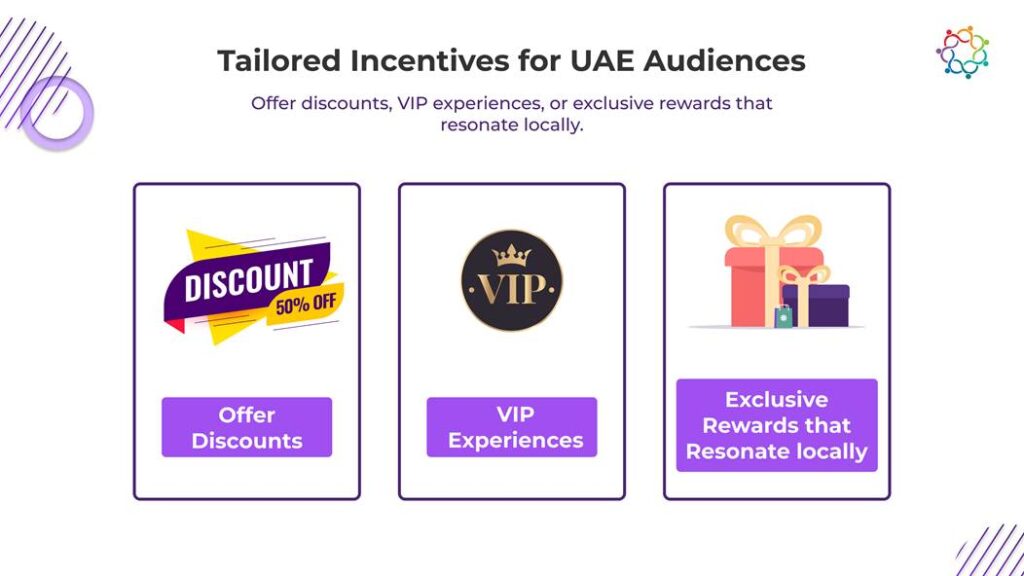
The UAE has a highly diverse population, with a mix of expatriates and local Emiratis who have different preferences when it comes to incentives. To create an effective referral program, it’s essential to align incentives with cultural expectations and consumer behavior.
Key factors influencing referral incentives in the UAE:
Several events and brands have leveraged referral incentives effectively:
When designing incentives, it’s important to ensure they are proportional to the value of the event itself.
By tailoring incentives to the preferences and expectations of UAE audiences, event organizers can build a referral program that drives organic registrations, enhances brand loyalty, and maximizes engagement.

The UAE has one of the highest social media penetration rates globally, making platforms like Instagram, Facebook, LinkedIn, Snapchat, and TikTok powerful tools for referral program promotion. Choosing the right platform depends on your target audience:
To drive referrals, content should be engaging, shareable, and action-oriented.

To measure the effectiveness of your referral program, track key performance indicators (KPIs) such as:
An effective reward system should be clear, easy to participate in, and enticing enough to motivate referrals. Consider:
By combining strategic social media promotions with robust tracking and rewards, your referral program can drive strong organic registrations while enhancing attendee engagement.
The UAE’s business ecosystem is built on strong networking and professional relationships. To create a successful referral program, event organizers should focus on connecting with influential stakeholders, business leaders, and industry groups who can act as referral advocates.
Key approaches:
Beyond formal networking, creating a community of enthusiastic referrers ensures long-term success. Strategies include:
By combining strategic networking and community-building efforts, organizers can create a referral network that grows organically, ensuring consistent attendee engagement for future events.

Collaborating with well-connected local partners can significantly boost referral program success. Key partners include:
To ensure mutually beneficial partnerships, organizers should:
By integrating well-aligned local partnerships, organizers can maximize referral impact, ensuring sustained growth for their event series in the UAE.
A well-executed referral program should not function in isolation—it should be seamlessly integrated into your overall event marketing strategy. By aligning referral efforts with email marketing, content marketing, and paid social campaigns, event organizers in the UAE can maximize reach and engagement.
To ensure a cohesive event promotion plan, referral initiatives should be embedded within multiple marketing touchpoints:
To evaluate the effectiveness of referrals in the overall marketing mix, event organizers should track:
Implementing UTM parameters, custom tracking links, and integrated CRM dashboards helps assess referral performance alongside other promotional efforts.
The UAE’s digital-first audience is rapidly adopting new referral strategies driven by:
With the rise of localized digital campaigns, referral marketing will continue to play a vital role in driving high-quality, organic event registrations.
A strong referral program can significantly boost event registrations in the UAE when combined with strategic planning and execution. The key takeaways include:
By implementing these best practices, event organizers can unlock sustainable organic growth while increasing brand engagement and attendance.
Samaaro is a trusted event management platform used by leading brands in the UAE to streamline event operations and enhance audience engagement. With seamless integration into referral and promotional strategies, Samaaro empowers organizers to drive maximum registrations and execute successful, high-impact events.

Built for modern marketing teams, Samaaro’s AI-powered event-tech platform helps you run events more efficiently, reduce manual work, engage attendees, capture qualified leads and gain real-time visibility into your events’ performance.


© 2025 — Samaaro. All Rights Reserved.